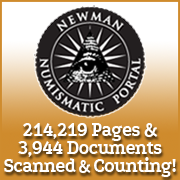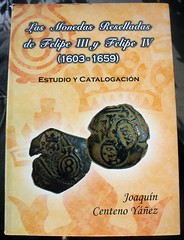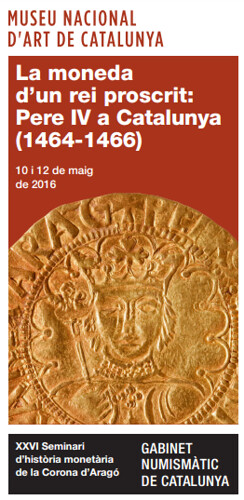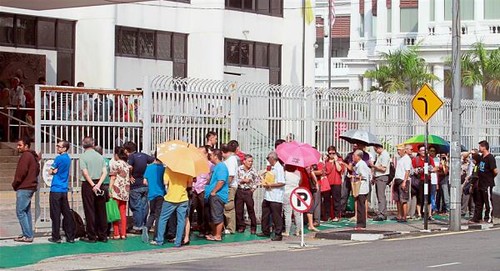
About UsThe Numismatic Bibliomania Society is a non-profit organization devoted to the study and enjoyment of numismatic literature. For more information please see our web site at coinbooks.org SubscriptionsThose wishing to become new E-Sylum subscribers (or wishing to Unsubscribe) can go to the following web page link MembershipThere is a membership application available on the web site Membership Application To join, print the application and return it with your check to the address printed on the application. Membership is only $20 to addresses in the U.S., $25 for First Class mail, and $30 elsewhere. For those without web access, write to: Terry White, Treasurer
AsylumFor Asylum mailing address changes and other membership questions, contact Terry at this email address: terrywhite5475@yahoo.com SubmissionsTo submit items for publication in The E-Sylum, just Reply to this message, or write to the Editor at this address: whomren@gmail.com BUY THE BOOK BEFORE THE COINSale Calendar |
- WAYNE'S WORDS: THE E-SYLUM MAY 1, 2016
- NEW BOOK: DELUXE RED BOOK 2ND EDITION
- NEW BOOK: WORLD PAPER MONEY, MODERN ISSUES, 22ND ED.
- BOOK REVIEWS: TWO BIBLIOTECA NUMISMATICA TITLES
- E-SYLUM EDITOR VIDEO INTERVIEW PUBLISHED
- NEWMAN PORTAL SCANS THE CIVIL WAR TOKEN JOURNAL
- THE INSTITUTE OF NUMISMATIC AUTHENTICATORS
- NOTES FROM E-SYLUM READERS: MAY 1, 2016
- QUERY: WHO WAS STICKNEY SALE BUYER "UNIT" OR "UNITE"?
- QUERY: PRE-1955 U.S. PROOF SET BOXES SOUGHT
- FRICK COLLECTION ACQUIRES SCHER EUROPEAN MEDALS
- COUNTERFEITER WILLIAM A. WAKEFIELD
- WHO'S WHO: VICTOR ENGLAND JR.
- NUMISMATICS AT NOTRE DAME VATICAN LIBRARY CONFERENCE
- SEMINAR ON COINAGE OF PETER IV IN CATALONIA
- HARVEY STACK ON STATE QUARTER COIN PROMOTIONS
- THE ORNATE CHARM OF EARLY AMERICAN CURRENCY
- CAJORI ON THE ORIGIN OF THE DOLLAR SIGN
- SELECTIONS FROM HERITAGE NEWMAN INTERNET PART 1 SALE
- LUNCHROOM LUNACY: OFFICIALS CALL GENUINE $2 BILL FAKE
- AMERICAN EUGENICS SOCIETY FITTER FAMILIES MEDALS
- WAYNE'S NUMISMATIC DIARY: MAY 1, 2016
- HUGE ROMAN COIN HOARD UNCOVERED IN SPAIN
- THE R. J. REYNOLDS JOSHUA COIN
- HOW HOWARD DANIEL GOT MPCS WHOLESALE
- ENGLAND'S £20 NOTE TO FEATURE ARTIST JMW TURNER
- ARCHIVES INTERNATIONAL APRIL 2016 SALES RESULTS
- MALAYSIAN COLLECTORS QUEUE UP FOR COMMEMORATIVES
- CLASSICAL NUMISMATIC GROUP SALE 102
- THE RISE OF PIRATE LIBRARIES
- MORE BOOKS BOUND IN HUMAN SKIN
- FEATURED WEB SITE: THE ROYAL NUMISMATIC SOCIETY
Click here to access the complete archive
To comment or submit articles, reply to whomren@gmail.com
WAYNE'S WORDS: THE E-SYLUM MAY 1, 2016
New subscribers this week include: Ryan Drake, courtesy of Tom Sheehan, David Heinrich of the Cincinnati Numismatic Association, and Bill Bierly. Welcome aboard! We now have 1,969 subscribers.
Welcome to our newest advertiser, numismatic literature dealer Douglas Saville. This week we open with two new books, two book reviews, a video, and an update on the Newman Numismatic Portal.
Other topics this week include U.S. Proof Set mailing boxes, the origin of the dollar sign, the Civil War Token Journal, dealer Victor England, numismatics at the Vatican Library, and Fitter Families medals.
To learn more about "Short rolls" of Statehood Quarters, the Joshua Coin, cob coinage, Pirate Libraries, C.W. Franklin's Numismatic Blue Book, the Scher Collection of medals, the coin cabinet of the Vatican Library and anthropodermic bibliopegy, read on. Have a great week, everyone!
Wayne Homren
Editor, The E-Sylum
NEW BOOK: DELUXE RED BOOK 2ND EDITION
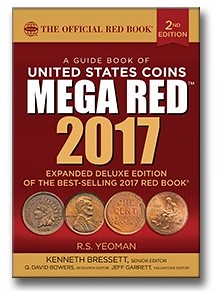 The second edition of Whitman Publishing's Guide Book of United States Coins, Deluxe Edition, popularly known as MEGA RED, debuted
at the Whitman Baltimore Coin and Collectibles Expo on March 31, 2016. Larger than the regular-edition Red Book, and with more pages, Mega Red
retails for $49.95. It can be ordered online (including at Whitman.com) and is available from booksellers and hobby shops nationwide. American
Numismatic Association members receive a 10% discount off all purchases from Whitman, since the publisher is the Official Supplier of the ANA.
The second edition of Whitman Publishing's Guide Book of United States Coins, Deluxe Edition, popularly known as MEGA RED, debuted
at the Whitman Baltimore Coin and Collectibles Expo on March 31, 2016. Larger than the regular-edition Red Book, and with more pages, Mega Red
retails for $49.95. It can be ordered online (including at Whitman.com) and is available from booksellers and hobby shops nationwide. American
Numismatic Association members receive a 10% discount off all purchases from Whitman, since the publisher is the Official Supplier of the ANA.
Advertised as the “biggest, most useful Red Book ever,” Mega Red measures 7 x 10 inches and has 1,504 pages. The larger size and increased page count combined make it five times bigger than the regular-edition Red Book. It prices 8,297 items in up to 13 grades each, with 47,000 individual values and 15,800 auction records covering circulated, Mint State, and Proof coinage. The book is illustrated with 5,800 images.
Like the first edition, the second edition of Mega Red covers American coinage from New England colonial times to the modern day—half cents through $20 gold double eagles, plus bullion, commemoratives, Proof and Mint sets, significant tokens and medals, error coins, and other numismatic collectibles. It follows the basic structure of the regular-edition Red Book, but each chapter is dramatically expanded with more grades and prices, more historical information, more die varieties, detailed grading instructions with enlarged full-color illustrations, specialized advice on strike characteristics and other technical details, market analysis, and valuable guidance on collecting and investing in rare coins.
The book's Senior Editor is Kenneth Bressett, Valuations Editor is Jeff Garrett, and Research Editor is Q. David Bowers. A 57-page introduction, “The Story of American Money,” is based on the work of the late Dr. Richard Doty, senior curator of the National Numismatic Collection at the Smithsonian.
Each year, the new Mega Red features an in-depth focus on one or more coin series. The first edition included a special 364-page section on copper half cents and large cents written by Q. David Bowers, with images, history, diagnostics, and pricing for 832 die varieties, 1793–1857.
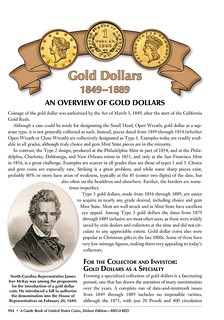
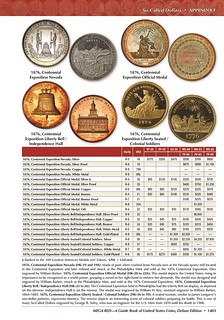
The second edition includes a detailed 330-page section on Flying Eagle, Indian Head, and Lincoln cents, covering 607 dates and varieties, plus patterns, counterstamps, errors, and other specialized topics.
For federal coins, detailed charts show each mintage; a summary of certified population data; average national retail prices in grades ranging from About Good to high Mint State and Proof; and three or more recent auction records for most coins. Enlarged close-ups of die varieties provide visual guidance. Extensive chart notes give the back stories and additional details on significant coins.
“We trademarked the name Mega Red when more and more collectors started referring to the Deluxe Edition by its nickname,” said Whitman publisher Dennis Tucker. “The first edition created a lot of excitement in the hobby community, and the second edition is even more exciting because its expanded feature covers three of the most popular coin series, the small cents of 1856 to date. That feature alone is the size of a normal book. Plus the second edition is full of updates, new essays, additional content, and more illustrations.”
In the second edition, coverage of pre-federal coins has been increased to include foreign coins that circulated in the British North American colonies: Spanish-American cob coinage of the 1500s to 1770s, Pillar coins of the 1700s, Bust coins of the 1770s to early 1820s, and various Dutch, French, and British copper and silver coin of the 1600s to early 1800s. “European coins of this era are so fundamental to American numismatics that every collection should include at least a sampling,” said Senior Editor Kenneth Bressett. The pre-federal chapters comprise 60 pages illustrated with 407 photographs, historical information, and pricing in multiple grades.
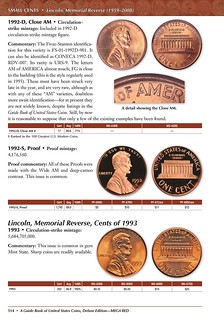
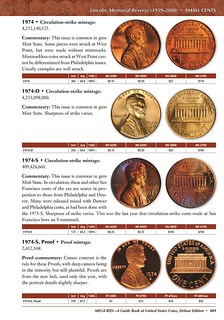
Recurring appendices include illustrated essays on misstrikes and error coins; rare and collectible Red Books and Blue Books; bullion values of common-date silver and gold coins; the top 250 coin prices realized at auction; and the ANA grading standards for U.S. coins.
New to the second edition are appendices on
- So-Called Dollars,
- Scouting and numismatics,
- the American Arts gold medallions of 1980 to 1984,
- modern U.S. Mint gold and silver medals,
- investing in modern gold and silver bullion,
- building a registry set, with insight from PCGS and NGC,
- determining coin prices and values,
- nationwide and specialized coin clubs and groups,
- how to get a new die variety into the Red Book, and
- collecting old and new numismatic literature.
Mega Red, 2nd edition (A Guide Book of United States Coins, Deluxe Edition)
ISBN 0794843921
Softcover, 7 x 10 inches
1,504 pages
Full color
Retail $49.95 U.S.
For more information, or to order, see:
2017
Official Red Book of United States Coins - Deluxe Edition
(www.whitman.com/store/Inventory/Detail/2017-Official-Red-Book-of-United-States-Coins---Deluxe-Edition+0794843921)
THE BOOK BAZARRE
NEW BOOK: WORLD PAPER MONEY, MODERN ISSUES, 22ND ED.
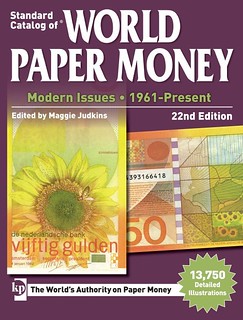 Standard Catalog of World Paper Money, Modern Issues, 22nd Edition
Standard Catalog of World Paper Money, Modern Issues, 22nd Edition
By Maggie Judkins
Format: Paperback
Utilizing a worldwide network of numismatics experts, the 22nd edition of the Standard Catalog of World Paper Money, Modern Issues provides the most comprehensive and complete reference to world bank notes issued since 1961.
This industry-leading catalog features:
- 22,000 variety listings of world bank notes
- 13,750 illustrations for easy identification of notes and signature varieties
- Bank note values in two popularly available conditions
- Country signature charts for specific and accurate variety identification
- Hundreds of new bank note issues
With contributions from an international team of collectors, dealers, researches and national bank officials working to ensure accuracy, the Standard Catalog of World Paper Money, Modern Issues is the most informed and all-encompassing resource on the market for the proper identification, description and valuation of modern world bank notes.
SKU S9926
Author/Speaker/Editor Maggie Judkins
Format Paperback
ISBN 13 9781440246562
Number Of Pages 1168
For more infornation, or to order, see:
Standard Catalog of World Paper
Money, Modern Issues, 22nd Edition (www.shopnumismaster.com/standard-catalog-of-world-paper-money-modern-issues-22nd-edition)
BOOK REVIEWS: TWO BIBLIOTECA NUMISMATICA TITLES
I have a copy of Las Monedas Reselladas de Felipe II y Felipe IV. It is quite a slim paperback catalogue of the copper coins in the Seventeenth Century which were countermarked up and down in value as inflation rose and fell. It is very comprehensive (as far as I can tell) and well-illustrated. It is easy to understand – if you read Spanish! I bought my copy on holiday in Barcelona at the shop of a dealer in Plaza del Angel.
Barry Stallard writes:
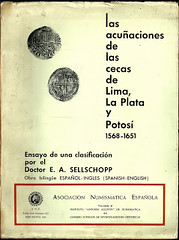 I am a regular reader of your weekly E-Sylum mailing and enjoy it very much. I can comment on the book Las Acunaciones de la
Cecas de Lima, La Plata y Potosi, 1568-1651 by Dr. E. A. Sellschopp. It was published by the Spanish Numismatic Association (ANE) in 1968 and is
bilingual (Spanish and English); it was subsequently reprinted in about 1992 with Paul Karon as editor.
I am a regular reader of your weekly E-Sylum mailing and enjoy it very much. I can comment on the book Las Acunaciones de la
Cecas de Lima, La Plata y Potosi, 1568-1651 by Dr. E. A. Sellschopp. It was published by the Spanish Numismatic Association (ANE) in 1968 and is
bilingual (Spanish and English); it was subsequently reprinted in about 1992 with Paul Karon as editor.
The book is a study by Sellschopp of the cob coinage struck in the Viceroyalty of Peru from 1568 to 1651. A useful utility of the book is that all 561 coins are described and photographed; of particular value to me is the study of the different lion and castle punches used to make the dies.
When I first began to collect these coins, I found the book very useful. A single date was added to the legend at Potosi beginning in 1617 (the Lima mint had long been closed before this date, not to re-open until a later date). However the coins were very crudely struck and for the dated period, a knowledge of the style of the coin and the punches used allows one to get an approximate date even when the date did not make it onto the coin. From my experience (over 40 years) well over 90% of the coins I've viewed can be found in the book (or a pictured example is shown that is closely similar in style).
There are however some very significant errors in the book. Coins identified as struck at the ephemeral mint of La Plata are incorrectly identified; they were actually struck at Potosi. Also the author attributed some of the early coins to Lima that properly belong to Potosi as archival research has shown.
Again, the value of the book is the coin images. I've found that the book can be purchased at Alan David Workman, Bookseller (www.workmansbooks.com).
To read the earlier E-Sylum article, see:
THE BIBLIOTECA NUMISMATICA BLOG (www.coinbooks.org/esylum_v19n17a06.html)
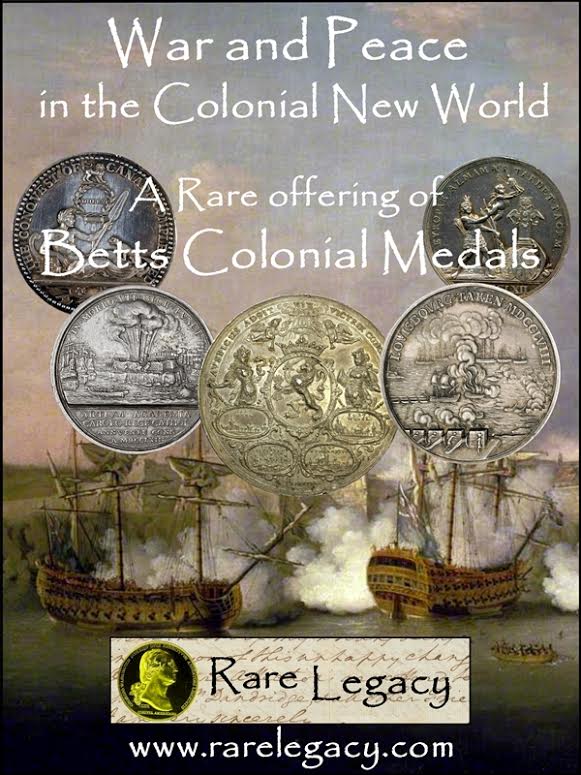
E-SYLUM EDITOR VIDEO INTERVIEW PUBLISHED
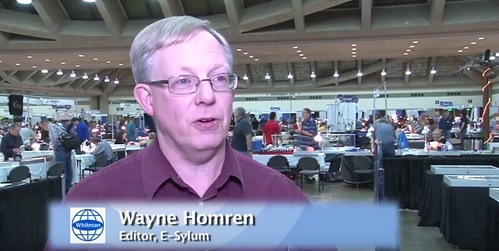
To view the video, see:
CoinTelevision: Wayne Homren Talks E-Sylum, Numismatic Bibliomania, & Newman Portal. VIDEO:
3:22. (https://youtu.be/kNJDR1_pozE)
To read the earlier E-Sylum article, see:
WAYNE'S NUMISMATIC DIARY: MARCH 31, 2016: PART 2
(www.coinbooks.org/esylum_v19n14a22.html)
NEWMAN PORTAL SCANS THE CIVIL WAR TOKEN JOURNAL

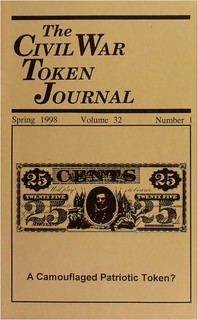 Joining the Newman Portal this week is the Civil War Token Society (CWTS), publishers of a quarterly journal since 1967. Issued under
multiple titles (Journal of the Civil War Token Society from 1967 to 1977, Copperhead Courier from 1978 to 1987, and The Civil War
Token Journal from 1988 to date), the Journal covers new discoveries in the field of Civil War tokens, member news, and a club auction featured
in each issue.
Joining the Newman Portal this week is the Civil War Token Society (CWTS), publishers of a quarterly journal since 1967. Issued under
multiple titles (Journal of the Civil War Token Society from 1967 to 1977, Copperhead Courier from 1978 to 1987, and The Civil War
Token Journal from 1988 to date), the Journal covers new discoveries in the field of Civil War tokens, member news, and a club auction featured
in each issue.
Thousands of varieties in the series (ably catalogued in the standard references by George and Melvin Fuld) ensure a wide array of collecting approaches, as well as the possibility of continued research finds. This is a ripe field for the collector seeking historical value at a reasonable price – these substitutes for one-cent pieces are more attractively priced than their federal brethren, and the storecards in particular invite Internet searches for the stories of the issuing merchants. The Newman Portal wishes to thank John Ostendorf, CWTS Secretary, for his assistance with this project.
Link to The Civil War Token Journal on the Newman Portal:
https://nnp.wustl.edu/library/publisherdetail/511836

THE INSTITUTE OF NUMISMATIC AUTHENTICATORS
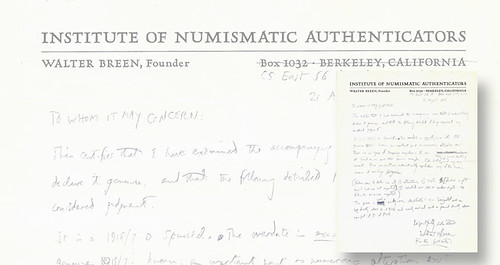
If you landed a time machine in 1961, you'd find yourself in an exciting but troubled time for coin collectors. The hobby was growing, people bought coins by the roll, and values zoomed like helium balloons. But villains lurked in every bourse and coin shop: counterfeit coins, along with their genuine but overgraded evil cousins. The numismatic marketplace was hot, but fakes and misdescribed coins made it a hot mess.
Hobby leaders found that educational programs alone could not cleanse the numismatic stable. Finally, some decided to divert a river through it, in the form of a third-party service to determine authenticity (and eventually, grade). The second such service, American Numismatic Association Certification Service, was founded in 1972, and the third, International Numismatic Society Authentication Bureau, was established in 1976. Thirty years ago, the first modern grading service, which certified authenticity, determined grade, and “slabbed” coins, Professional Coin Grading Service, opened its doors.
PCGS and ANACS are still industry leaders, but the very first such service is forgotten today. The Institute of Numismatic Authenticators or INA was founded in 1962 by that era's ultimate numismatic scholar, Walter H. Breen. He recruited Don Taxay, a rising star coin dealer, and Lynn Glaser, a numismatic prodigy. One of these three hotshots would examine a coin, then issue a handwritten certificate of genuineness on INA letterhead, explaining the reasons for their determination.
It was numismatic brainiacs against the counterfeiters, but the heroes immediately encountered problems. INA neither encapsulated nor photographed the coins they examined, so it was easy for crooks to submit a genuine coin in order to get an INA certificate, then switch out the genuine piece for a bogus one.
But the biggest reason INA quickly folded was sloppy “safeguards.” As fellow Coin World columnist David Alexander has written, INA's “office” was Breen's fourth-floor walk-up New York apartment, and the absent-minded Breen lost several valuable coins in his own clutter, including an 1804 Draped Bust gold eagle eventually found, after a frantic search, languishing under a sink!
INA went belly-up in 1963, but Breen retained the letterhead, and used it for years thereafter, as demonstrated by the illustrated certificate from Aug. 21, 1968. Breen, bewhiskered and resplendent in his tie-dyed shirts, shorts and sandals, was regularly approached on the bourse for on-the-spot coin authentication. Ironically, someone began forging Breen's certificates, and he responded by writing with a highly distinctive violet ink.
This “pre-violet” 1968 certificate focused on a 1918/7-D Indian Head 5-cent coin, which Breen "unhesitatingly" declared genuine because: the overdate is identical to all known originals; the coin shows no signs of tampering; it has all of the required diagnostics. He even graded it as “Good +.” The coin was long ago separated from the certificate and probably resides in a modern slab.
To read the complete article, see:
A U.S. coin ‘authentication
service' in 1962?: Numismatic Bookie
(www.coinworld.com/news/us-coins/2016/04/first-coin-authentication-service-founded-in-1961.html)
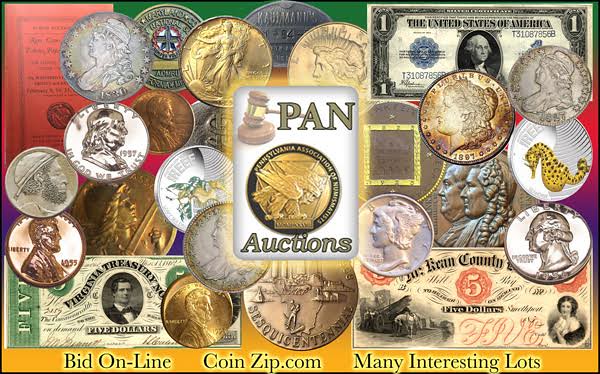
NOTES FROM E-SYLUM READERS: MAY 1, 2016
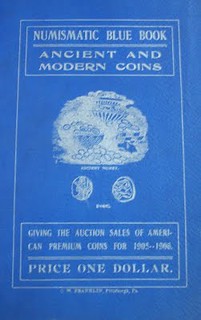 C.W. Franklin's Numismatic Blue Book
C.W. Franklin's Numismatic Blue Book
Dan Hamelberg writes:
John Lupia should be pleased to know his copy of C.W. Franklin's "Numismatic Blue Book" is not the only one. I have a copy that I got from an August 31, 1996 Money Tree sale. It has a stamp on the inside cover page of "Aug 19 1907, The Ohio National Bank, Columbus, Ohio, L.F. Kiesewetter, Cahsier." Nice to see it was actually used by a Bank in its day.
To read the earlier E-Sylum article, see:
C. W. FRANKLIN (www.coinbooks.org/esylum_v19n17a16.html)
On Storing Numismatic Book Jackets
Dave Lange writes:
Regarding the subject of numismatic book jackets, I always store mine separately inside boxes. I know that they'll get shredded with the frequent use many of my books receive. Though the books may become worn, they'll look all dressed up when the time comes to sell my library, as the dust jackets will remain Near Mint.
This practice has backfired on me a few times, as I sometimes sell older editions of books no longer needed and forget that I have their dust jackets tucked away. A few years ago I took an inventory and found about half a dozen for which I no longer owned the books. I listed these as a single lot on eBay, but it took a long time for them to sell. They were mostly for hardbound auction catalogs, and I'd simply forgotten that these had been issued with dust jackets when I consigned the catalogs to one of our book dealer friends.
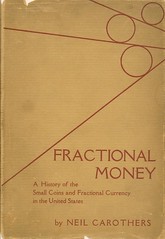 That's why I like the Brodart dust jacket covers, despite the work involved in putting them on. Shown here is probably my favorite
numismatic dust jacket, a very rare one for Carothers'Fractional Money.
That's why I like the Brodart dust jacket covers, despite the work involved in putting them on. Shown here is probably my favorite
numismatic dust jacket, a very rare one for Carothers'Fractional Money.
I hope we don't someday have a similar problem with our daughter's American Girl dolls. Last night I boxed up several empty doll boxes destined for our attic. Someday the dolls can be reunited with their original boxes if only we remember we still have them. -Editor
To read the earlier E-Sylum articles, see:
NOTES FROM E-SYLUM READERS: APRIL 17, 2016
(www.coinbooks.org/esylum_v19n16a07.html)
MORE ON NUMISMATIC BOOK DUST JACKETS
(www.coinbooks.org/esylum_v19n17a12.html)
Coins Delisted From the Redbook
Regarding coins removed from A Guide Book of United States Coins over the years, Tom DeLorey writes:
The Good Samaritan Shilling is not the only "coin" to be delisted from the Redbook. The "Blake & Co. $20" associated with John Ford has gone down the memory hole, along with other questionable Western items associated with him.
Back in 1974 while I was working at Coin World, I saw a letter addressed by Mr. Ford to the Editor of the Numismatic Scrapbook Magazine. In the letter Mr. Ford assured the Editor that various items listed in the Redbook in the 1960's had been removed from the Redbook "due to lack of space." Mr. Bressett assures me that this was not the case.
To read the earlier E-Sylum article, see:
GERALD TEBBEN CONTINUES LOOK AT THE RED BOOK
(www.coinbooks.org/esylum_v19n17a10.html)
Numismatic Treasures from World Trade Center Attack
Martin Kaplan writes:
A fascinating article would be what numismatic treasures were incinerated when the Twin Towers collapsed. Have you ever seen anything reported about that? I'm sure there must have been "oodles" of bullion and gemstones too
To read the earlier E-Sylum articles, see:
SEPTEMBER 11 COINS (www.coinbooks.org/esylum_v06n32a20.html)
FREEDOM TOWER "COINS" RULED A FRAUD
(www.coinbooks.org/esylum_v07n46a11.html)
FREEDOM TOWER "COIN" CLASS ACTION SUIT FILED
(www.coinbooks.org/esylum_v08n29a12.html)
The Queen Still Rides at 90
An E-Sylum reader writes:
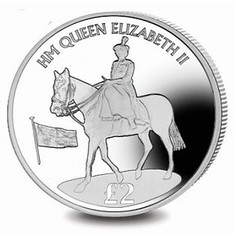 The coin showing the Queen on horseback is a South Georgia & South Sandwich Islands £2. It is one of a series of crown-sized coins produced
by Pobjoy Mint for the Queen's 90th birthday. All depict major events in Her Majesty's life. The SGSSI £2 coin shows the Queens very first ‘Trooping
the Colour' ceremony in 1952 - when she was 26 years old and in the first year of her reign.
The coin showing the Queen on horseback is a South Georgia & South Sandwich Islands £2. It is one of a series of crown-sized coins produced
by Pobjoy Mint for the Queen's 90th birthday. All depict major events in Her Majesty's life. The SGSSI £2 coin shows the Queens very first ‘Trooping
the Colour' ceremony in 1952 - when she was 26 years old and in the first year of her reign.
At 90 the Queen still rides and still does so without a helmet as she has done all her life. She had her first riding lesson at age 3 and was given her first pony, a Shetland mare, by grandfather King George V when she turned 4. The coin shows her riding side-saddle - as was required by a woman. As a top rider she loathes doing so. Most of her family are serious riders. It is part and parcel of being a British royal. Her daughter of course has ridden in the Olympics.
To read the earlier E-Sylum article, see:
NOTES FROM E-SYLUM READERS: APRIL 24, 2016 : More On Equestrian Depictions of QEII
on Coinage (www.coinbooks.org/esylum_v19n17a13.html)
Mechanical Musical Instrument Award for Dave Bowers

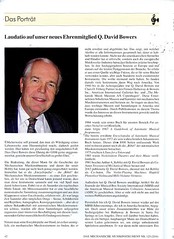
Dave's 1,000+ page book, Encyclopedia of Automatic Musical Instruments, was released in 1972 and has sold over 20,000 copies worldwide. Some of his research was done in West Germany and behind the Iron Curtain (at the time) with special permission from the the East German government. He was co-owner of a museum in Copenhagen at the time. Congratulations, Dave! -Editor
Prehistoric Email
Howard A. Daniel III writes:
The Major Eras of Numismatic Research item brought back many OLD memories for me.
A couple of weeks after a briefing at SOG Studies & Operations Group headquarters (it was a weak cover name for Special Operations Group) in late July 1970 in Saigon, I suddenly received orders to an intelligence unit in Germany.
I arrived in Heidelberg in August 1970 and was surprised to see some Digital Equipment Corp. (DEC) taking over part of the computer room for an IBM 360-50. What was it doing here? As the new Operations NCOIC, I should know about everything in my area of responsibilities, so I walked up to the senior operator on duty and asked him to explain what was going on.
 It turned out to be an ARPANET test site. ARPANET was the organization which invented what became the Internet and it was there to test the
sending of our intelligence through their system. Could anyone "see" what was being sent? I sat down at the console and the senior operator
taught me how to operate it, and he assigned me what became later, an "email" address. He told me of a mutual friend back in the USA in one
of the major intelligence agencies! So I sent my first "email" to this friend in August 1970.
It turned out to be an ARPANET test site. ARPANET was the organization which invented what became the Internet and it was there to test the
sending of our intelligence through their system. Could anyone "see" what was being sent? I sat down at the console and the senior operator
taught me how to operate it, and he assigned me what became later, an "email" address. He told me of a mutual friend back in the USA in one
of the major intelligence agencies! So I sent my first "email" to this friend in August 1970.
We only used dummy information in the tests. Anyone and everyone with the capability of tapping into our signal could read everything because those were the days before encryption for this new type of communications. So we ended the test; the equipment was returned to ARPANET; and we went back to using couriers to get bulk intelligence back to the intelligence agencies back in the USA.
I remember back in the 1980s and 1990s, I would receive surveys asking me when I first used the Internet, when I sent my first email, etc., etc. When I replied that it was in August 1970, they would contact me and tell me that I had incorrectly typed in the wrong year. I would explain the above to them and they would then accept it, but my entry was never used because the published results was always many years after my date!
Now I correspond via emails with almost 1,200 different numismatists and those in related fields worldwide, and over 800 more via Facebook! The world has really changed!!!
To read the earlier E-Sylum article, see:
THE MAJOR ERAS OF NUMISMATIC RESEARCH
(www.coinbooks.org/esylum_v19n17a09.html)
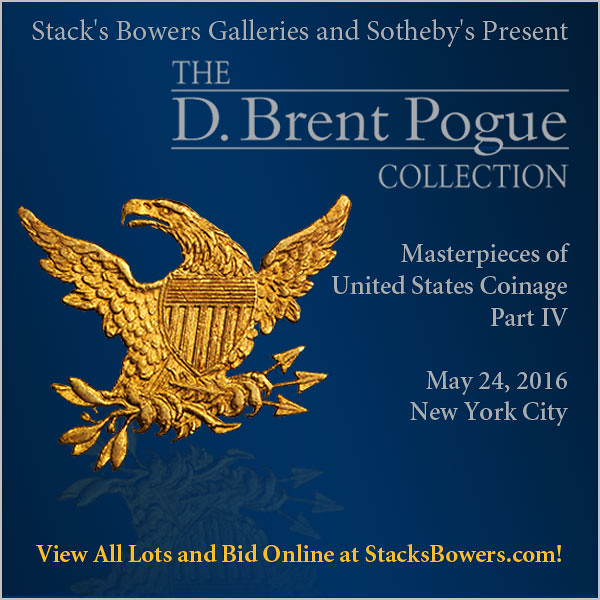
QUERY: WHO WAS STICKNEY SALE BUYER "UNIT" OR "UNITE"?
Saul Teichman writes:
Do any of the Esylumites have a named Stickney catalog with the decoded names in the back ? We are trying to find out who "Unit" or "Unite" below is ?
With regard to the Stickney sale, there are two 1839 dollars in the sale, the second is likely his as it is after the 1804 dollar. Elder bought the first, and "Unit" or "Unite" bought the second. I do not see any section at the end with a listing of the code to see who bought it.


QUERY: PRE-1955 U.S. PROOF SET BOXES SOUGHT

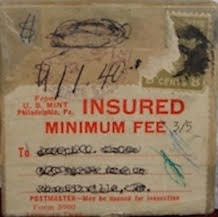
Bob Rightmire writes:
I am looking for images of US Proof set boxes, prior to mid 1955, that were shipped with either metered postage (see examples above) or with a US postage stamp affixed. A postage fee below 8 cents is of particular interest. I'm also hoping to confirm that “velvet lined” envelopes were used for shipping some proof coins, by the US Mint, prior to the 1950s.

FRICK COLLECTION ACQUIRES SCHER EUROPEAN MEDALS
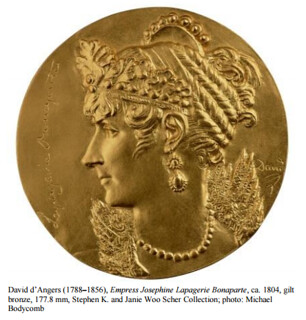 The Frick is pleased to announce a promised gift of portrait medals from the Stephen K. and Janie Woo Scher Collection. Considered to be
the world's greatest medals collection in private hands, rivaling and often surpassing those in American museums such as the National Gallery of Art,
The Metropolitan Museum of Art, and the Los Angeles County Museum of Art, it is noted for its comprehensiveness and outstanding quality.
The Frick is pleased to announce a promised gift of portrait medals from the Stephen K. and Janie Woo Scher Collection. Considered to be
the world's greatest medals collection in private hands, rivaling and often surpassing those in American museums such as the National Gallery of Art,
The Metropolitan Museum of Art, and the Los Angeles County Museum of Art, it is noted for its comprehensiveness and outstanding quality.
An initial gift of about 450 medals will beautifully trace the development of the art of the medal from its inception in the fifteenth century through the nineteenth century. Among the strengths of the collection—which includes examples from Italy, France, Germany, England, and The Netherlands—are superlative works by the masters Pisanello (Italy), Dupré (France), Reinhart (Germany), and Jonghelinck (Netherlands). A selection of the portrait medals will be featured in a major spring/summer exhibition opening in May of 2017. The show will be accompanied by public programming and an in-depth scholarly publication that catalogs the entirety of this important collection.
Comments Director Ian Wardropper, “Henry Clay Frick had an abiding interest in portraiture as expressed in the paintings, sculpture, enamels, and works on paper he acquired. The Scher medals will coalesce beautifully with these holdings, being understood in our galleries within the broader contexts of European art and culture. At the same time, the intimate scale of the institution will offer a superb platform for the medals to be appreciated as an independent art form, one long overdue for fresh attention and public appreciation.”
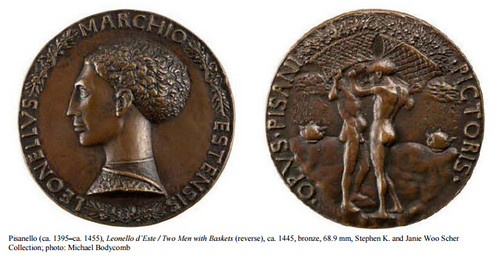
Adds Peter Jay Sharp Chief Curator Xavier F. Salomon, “The Frick and the Schers have enjoyed a lengthy and rewarding relationship. Stephen Scher organized the landmark exhibitions The Currency of Fame (The Frick Collection and the National Gallery of Art, 1994) and The Proud Republic: Dutch Medals of the Golden Age (The Frick Collection, 1997).
A world-renowned scholar, Dr. Scher has the ability to instill in new audiences an enthusiasm and appreciation for these remarkable objects. He brings to life these masterpieces of small-scale sculpture, compellingly conveying the circumstances of their creation and their historic significance today. The Frick has enjoyed hosting Dr. Scher as an educator on many occasions, from large public lectures to intimate scholarly seminars and school groups, and we look forward to developing programs with him in conjunction with the upcoming exhibition.”
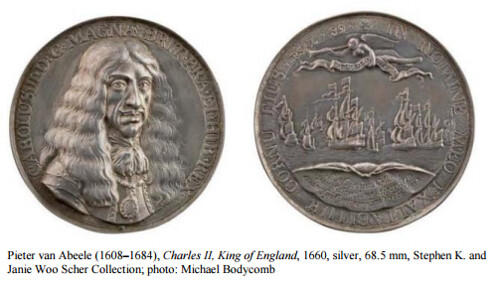
To read the complete press release, see:
FRICK TO RECEIVE THE MOST IMPORTANT
PRIVATE COLLECTION OF PORTRAIT MEDALS (www.frick.org/sites/default/files/pdf/press/ScherMedalsGiftReleaseApril2016.pdf)
COUNTERFEITER WILLIAM A. WAKEFIELD
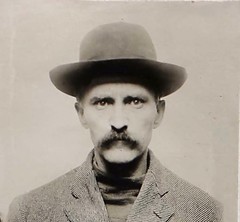
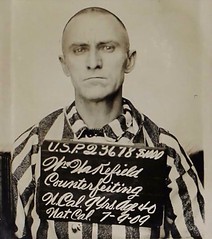
William A Wakefield was born in California in 1864. He became a professional gambler in the Old West. He traveled from one place to another looking for high stake games. During the late 1890's he took an interest in the mining camps in Colorado where he worked for a while. As chance would have it he took a three year break from that business traveling in Colorado and Kansas, which we shall get to later, and returned to California looking for work.
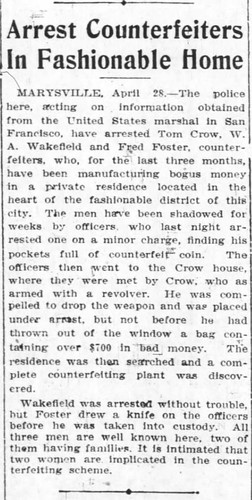 By 1909 he was working as a clerk. He entered the employment of a certain Tom Crow of San Francisco in the fashionable suburbs of
Marysville. Together with Fred Foster these three men became partners as unofficial coiners of the United States Mint at San Francisco. Another man
was the fence for the counterfeit coins at Sacramento and another at Chico, California. Two women were also accomplices passing bad money in San
Francisco. When the bust came it was estimated to be the largest counterfeiting gang ever in the history of the State of California. Apparently they
counterfeited bogus quarter eagles or $5 gold pieces.
By 1909 he was working as a clerk. He entered the employment of a certain Tom Crow of San Francisco in the fashionable suburbs of
Marysville. Together with Fred Foster these three men became partners as unofficial coiners of the United States Mint at San Francisco. Another man
was the fence for the counterfeit coins at Sacramento and another at Chico, California. Two women were also accomplices passing bad money in San
Francisco. When the bust came it was estimated to be the largest counterfeiting gang ever in the history of the State of California. Apparently they
counterfeited bogus quarter eagles or $5 gold pieces.
According to the U. S. Census, 1910 at Kickapoo, Kansas, he was serving time in the United States Penitentiary at Fort Leavenworth. According to his prison record he was serving his second term, known in layman's terms as a two-time-loser. He was previously arrested and served time in Colorado under the assumed name of William W. Elliott, and was transferred to Fort Leavenworth Penitentiary.
He was released from Fort Leavenworth Penitentiary on February 25, 1916. Wakefield died on May 4, 1935 at Los Angeles, California.
To read the complete article, see:
WAKEFIELD, WILLIAM A
(https://sites.google.com/a/numismaticmall.com/www/numismaticmall-com/wakefileld-william-a)
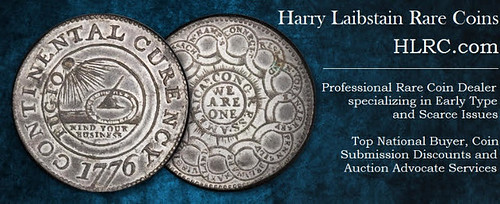
WHO'S WHO: VICTOR ENGLAND JR.
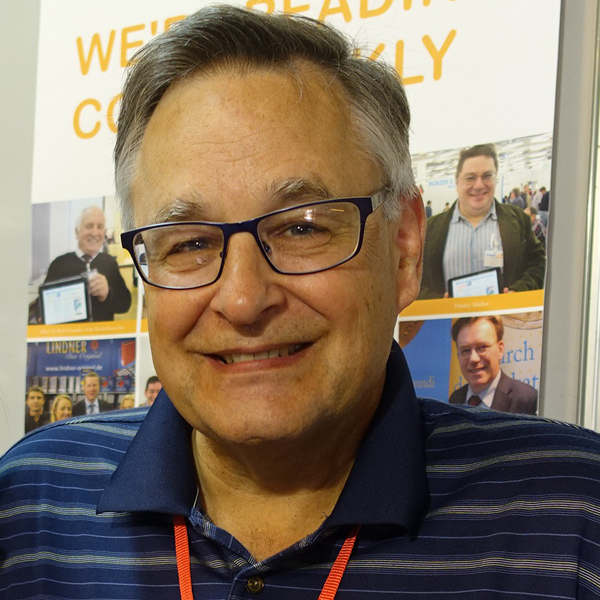 Victor England Jr.
Victor England Jr.
Coin Collector with heart and soul
Victor England graduated from the University of Denver / Colorado with a B.A. in Economics and, in 1975, became a full-time freelance coin dealer, first with the Denver-based company Victor England Ltd., focusing on the trade in ancient and medieval coins and medals. In 1986, Victor England changed the company's name to Classical Numismatic Auctions, Ltd. Together with Eric McFadden, he founded Classical Numismatic Group, Ltd. in 1990, with offices in Quarryville / PA and Beverly Hills / CA. In 1991, CNG took over the venerable coin company Seaby Ltd. in London. The Beverly Hills office was closed.
Since that time, Victor England is responsible for the U.S. American branch of CNG. Under his direction, the company evolved into one of the world's leading auction houses for ancient coins. His decision to enrich the printed CNG catalogs by coin descriptions that are based on latest scientific findings has made these publications a benchmark.
Victor England realized very soon how important the internet was. On his initiative, CNG was among the first coin companies that began online sales and online auctions. On its website, therefore, the company is able to make an extensive archive of the objects sold since 2000 accessible to the general public.
Victor England is the editor and co-initiator of a catalog project that is of major importance to collectors: the ‘Handbook of Greek Coinage'. He considers the promotion of literature collectors can make use of so vital that CNG has become an important publisher of numismatic works written in English.
In Great Britain, CNG established a fund for studies in Roman and Byzantine numismatics. CNG also sponsors an annual numismatic lecture held in the Ashmolean Museum in Oxford.
In 2010, Victor England was honored with the ANS Trustees' Award. In 2015, he was elected Dealer of the Year, together with Harry J. Forman. He is a member of the trade organization International Association of Professional Numismatists (IAPN) and, as a member of the International Bureau for the Suppression of Counterfeit Coins (IBSCC), is engaged in the fight against counterfeiting.
To read the complete article, see:
Victor England Jr.
(www.coinsweekly.com/en/Numismatic-Whos-Who/Victor-England-Jr/42)
NUMISMATICS AT NOTRE DAME VATICAN LIBRARY CONFERENCE
Eleanora Giampiccolo, The coin cabinet of the Vatican Library: history and collections
Mariele Valci, The denari provisini preserved in the Medagliere of the Vatican Library
Paolo Visonà, Greek Illyrian and Carthaginian Coins in the Collection of the Vatican Library
CONFERENCE RATIONALE
In 1451, Pope Nicholas V decreed that, “for the common convenience of the learned, we may have a library of all books both in Latin and Greek that is worthy of the dignity of the Pope and the Apostolic See.” Founded as humanism in Europe was on the ascent, the Vatican Library's holdings were not (as many wrongly believe) primarily theological or ecclesiological in character. Rather, all manner of human knowledge and creativity found their place in the Popes' Library. Indeed, the founder's original intent has only been expanded: holdings are not limited to Latin and Greek works, but include a remarkable array of works from throughout the world and across time. The Vatican Library—as the prototypical research library—stands as a testament to the Church's affirmation of human reason, its commitment to the search for truth, and its confidence in the harmony of reason and faith.
The Vatican Library's holdings today include approximately 180,000 manuscripts (of which 100,000 are made up of archival materials), nearly 9,000 incunabula, 150,000 prints, drawings, maps, and engravings, over 150,000 photographs, 300,000 coins and medals, and 1.6 million modern printed books. The manuscript collection is arguably the most important in the world, including such treasures as the Codex Vaticanus of the Bible, the Vatican Vergil, the Dante Urbinate, and other manuscripts which are the sources used to produce modern editions of thousands of other texts.
Perhaps more noteworthy than the quantity of materials held in the Vatican Library, or the scholarly value of its collection, is the fact that its holdings are remarkably unknown. Colloquially referred to as the “Attic of Civilization,” the Library holds enormous potential for researchers from widely divergent disciplines. The goal, therefore, of this conference, is to quicken the utilization of the Vatican Library and to promote its value as a resource for scholarship and teaching, especially in fields related to medieval and renaissance studies.
To read the complete article, see:
VATICAN LIBRARY CONFERENCE
(http://vaticanlibrary.nd.edu/schedule-and-presenters/)

SEMINAR ON COINAGE OF PETER IV IN CATALONIA
Here is another Spanish numismatic event coming up soon. I have met a couple of the speakers. Unfortunately for me, I'm dreadfully weak in Catalan! And this looks to be pretty specialized…
It is a mini-seminar, on May 10 and 12 at the MNAC (the National Museum of Art of Catalunya) entitled (in English, if I may) 'Coinage of a Proscribed King: Peter IV in Catalonia.' The occasion marks the 550th anniversary of the Aragonese king's death, and the acquisition, by the MNAC's numismatic cabinet, of an exceptional example of the gold 'Pacific' -- a new coin denomination introduced by this monarch.
For more information, see:
http://www.museunacional.cat
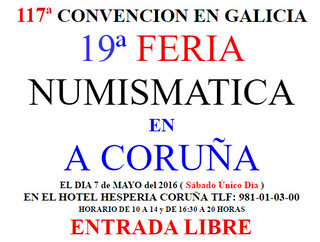 Robert also sends word of the upcoming convention of the Spanish Numismatic Association (Asociación Numismática Española) in Barcelona May
7, 2016. -Editor
Robert also sends word of the upcoming convention of the Spanish Numismatic Association (Asociación Numismática Española) in Barcelona May
7, 2016. -Editor
For more information, see the Association's web site:
www.numisane.org
Robert adds:
I am now a member of the ANE (Asociación Numismática Española -- now seemingly trying to re-brand itself as Asociación Numismática Europea!) and the CFNB (Cercle Filatèlic i Numismàtic de Barcelona), the two main numismatic organizations hereabouts.
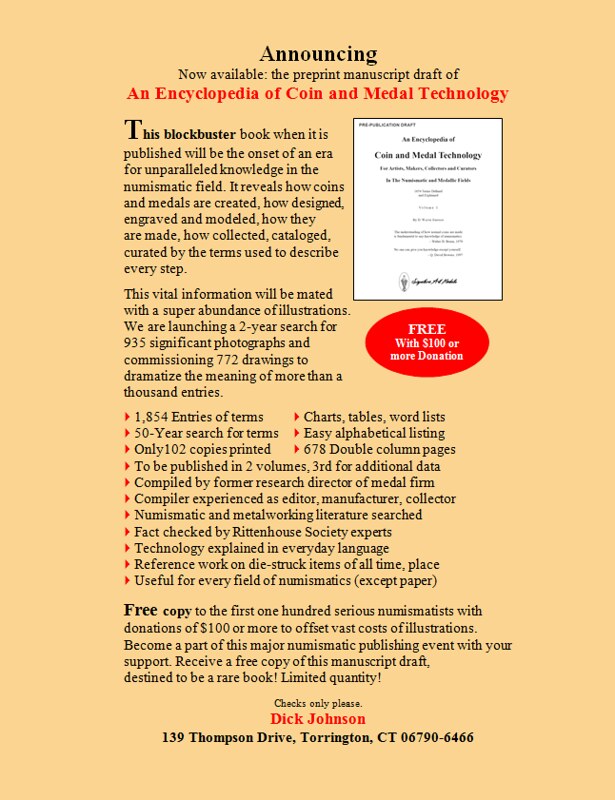
HARVEY STACK ON STATE QUARTER COIN PROMOTIONS
The State Quarters Treasure Chest
RESERVE NOW before the limited supply is gone forever!
 Minting has officially ended on the U.S. State Quarters and this closes one of the most thrilling issues in the history of U.S. coinage.
However, you can still build a breathtaking heirloom-quality collection of these historic coins through the Danbury Mint!
Minting has officially ended on the U.S. State Quarters and this closes one of the most thrilling issues in the history of U.S. coinage.
However, you can still build a breathtaking heirloom-quality collection of these historic coins through the Danbury Mint!
While our limited reserves last, you may acquire exclusive collector rolls featuring 12 of each individual quarter design...all in pristine, never-circulated condition in a protective vault tube and sealed to preserve their condition for generations to come. And, with each collector roll, you'll receive a FREE bonus coin...a 13th quarter for the state, protectively encapsulated so you can closely inspect and showcase it.
$19.95 per roll +$4.95 Shipping & Service each 1 Payment of $24.90 for your first roll
Harvey writes:
Don't you feel that this is the great bargain of the century and a super investment for you and your family ???
Short rolls of Statehood Quarters at extremely "Low Prices", so low that I am willing to save you a place on line so you will be sure to scoop up a bargain !!??
Look at that for an investment in the future. It is bad enough that the Mint ads are $17.50 for a FULL ROLL OF 40, WHEN YOU CAN GET 13 FOR $29,95. , WHEN THEY REALLY SHOULD BE AVAILABLE AT YOUR BANK FOR $10,00 FOR A ROLL OF 40.
I am so ashamed that I thought of this idea of trying to make more collectors, by having something of interest at face value to collect and here are a bunch of guys trying to tell you and me what a bargain they have.
Of course there's the wooden case, if it will be strong enough to carry 50 rolls (probably on their rolls of 13 not 40 as we can get from a bank)
Will the wonders of Numismatic Promotions never cease ???
See, my simple numismatic mind has created a world class monster !!!!! Can you help me with my dilemma?
CoinWeek and other publications have spoken out for more consumer protections for buyers being lured into purchasing overpriced offerings only to have their hopes of profiting dashed when they try to sell their treasures.
I agree that it's good to raise awareness of these problems and perhaps some additional consumer regulations may be in order. But note that the seller is not making any reference to investment, only offering a "breathtaking heirloom-quality collection" Earlier regulations and lawsuits have pushed those claims aside.
But purchasers will still have a problem when they or their heirs attempt to sell their "breathtaking heirloom-quality collection".
That said, I would caution against throwing the baby out with the bathwater. These circulating commemorative programs are still a wonderful thing for the hobby and the general public. If marketers weren't touting these in the aftermarket, they'd be dreaming up something else. Harvey should remain proud of his accomplishment. His testimony in Congress led to the creation of a great program, and aggressive post-Mint marketing can't taint that.
Later in this issue is a story about collectors in Malaysia snapping up commemoratives for their collections. -Editor
To read the complete product offers, see:
(http://www.danburymint.com/prod/2C3/Land-of-the-Free-State-Quarters_9447-0184)
The State Quarters Treasure Chest
(http://www.danburymint.com/prod/E02/The-State-Quarters-Treasure-Chest_8977-0085)

THE ORNATE CHARM OF EARLY AMERICAN CURRENCY
With Harriet Tubman coming to the American $20 bill, and other changes being made to the look of money in the United States, the design of dollars is once again set to evolve. But our current bills still hold many of the symbols and motifs that existed in our earliest paper money, the Colonial and Continental currencies.
Back then, when the bills were being produced by each of the colonies, they were both wilder and more elaborate. Incorporating early versions of the filigree and emblems, like the pyramid, still found in American currency today, these proto-dollars are terrific artifacts from a more primitive economy. Until 1797, they did not even use the "$" symbol, which had to be invented by a bankrupt Irishman first.
Take a look at some of the most gorgeous money from the 1700s.
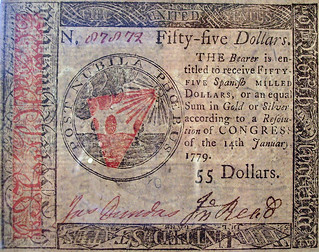
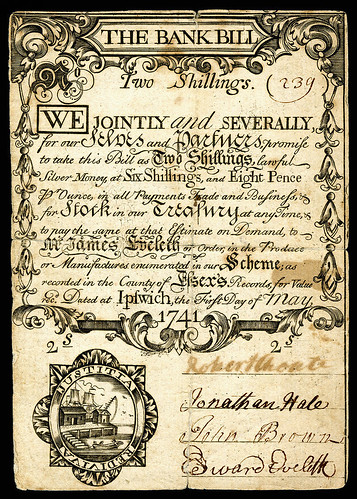
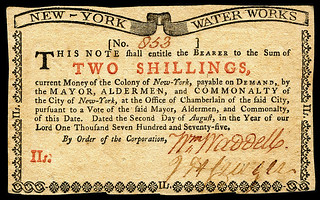
To read the complete article, see:
The Ornate Charm of American Currency
from the 1700s (www.atlasobscura.com/articles/the-ornate-charm-of-american-currency-from-the-1700s)
To read the complete article, see:
The Unexpected Individuals Featured
on American Currency (www.atlasobscura.com/articles/the-unexpected-individuals-featured-on-american-currency)
CAJORI ON THE ORIGIN OF THE DOLLAR SIGN
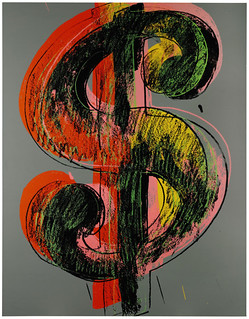 It is sometimes said that the dollar sign's origin is a narrow "U" superimposed over a wide "S", "U.S."
being short for "United States." This is wrong, and the correct explanation also tells why the $ sign is used both for dollars and for
pesos in various countries. The explanation is not widely known, maybe because not many people would think to look for it in a book called A
History of Mathematical Notations, Volume II: Notations Mainly in Higher Mathematics by Florian Cajori (published in 1929 and reprinted
in 1952, by Open Court Press). Cajori acknowledges the "U.S." theory and a number of others, but, after examining many
18th-century manuscripts, finds that there is simply no evidence to support those theories.
It is sometimes said that the dollar sign's origin is a narrow "U" superimposed over a wide "S", "U.S."
being short for "United States." This is wrong, and the correct explanation also tells why the $ sign is used both for dollars and for
pesos in various countries. The explanation is not widely known, maybe because not many people would think to look for it in a book called A
History of Mathematical Notations, Volume II: Notations Mainly in Higher Mathematics by Florian Cajori (published in 1929 and reprinted
in 1952, by Open Court Press). Cajori acknowledges the "U.S." theory and a number of others, but, after examining many
18th-century manuscripts, finds that there is simply no evidence to support those theories.
Spanish pesos were also called piastres, Spanish dollars, and pieces of eight. (The piece of eight was so called because its value was eight reales. Some countries made one-real coins by slicing pieces of eight into eight sectors; the still-current U.S. slang "two bits" for a quarter of a dollar may refer to this, although "bit" denoting any small coin -- as in "threepenny bit" -- was already in use.) The coins were circulated in many parts of the world, much as U.S. dollars are today. The coins were so well known that, when the U.S. got around to issuing its own silver coinage (U.S. dollar coins first appeared in 1794), it simply replicated the Spanish unit's weight and hence value, and even one of its names; so it was natural to use the same symbol.
Since three of the four names given above for the Spanish dollar start with p (and pluralize with s), it was natural for abbreviations like p and ps to be used. Sometimes ps was written s as P -- P with a superscript s. The superscript was a common way of rendering abbreviated endings of words -- we see vestiges of it today in the way some people write "10th". Now, what happens if you write P with a superscript s *fast*, because it's part of a long document that you have to hand-write because you can't wait for the typewriter to be invented, let alone the word-processor? Naturally, you join the letters. Well, now look at the top part of the resulting symbol. There's the $ sign! Reduce the P to a single stroke and you have the form of the $ with a double vertical; omit it altogether and you get the single vertical.
And yes, both these forms are original. Cajori reproduces 14 $ signs from a diary written in 1776; 11 of them have the single stroke, which was the more common form to the end of the century, and 3 have the double stroke.
Although the $ sign originally referred to a Spanish coin, it was the revolting British -> American colonists who made the transition from ps to the new sign. (This is apparently also why we write $1 instead of 1$; it mimics the British use of the pound sign.) So, while it did not originally refer to the U.S. dollar, the symbol does legitimately claim its origins in that country.
To read the complete article, see:
Origin of the dollar sign
(http://alt-usage-english.org/excerpts/fxorigin.html)
To read the earlier E-Sylum articles, see:
THE ORIGINS OF THE DOLLAR SIGN (www.coinbooks.org/esylum_v10n08a12.html)
THE AMERICAN ACCOMPTANT: 1797 BOOK USING DOLLAR SIGN
(www.coinbooks.org/esylum_v14n26a18.html)
MORE ON THE AMERICAN ACCOMPTANT AND THE FIRST PRINTED DOLLAR SIGN
(www.coinbooks.org/esylum_v14n30a10.html)
ARTICLE CREDITS OLIVER POLLOCK WITH CREATING DOLLAR SIGN
(www.coinbooks.org/esylum_v18n48a15.html)

SELECTIONS FROM HERITAGE NEWMAN INTERNET PART 1 SALE
If you haven't yet perused the fascinating items in this sale, there is still a little time left. A few of the many highlights are listed below.
Lot 86299: Vermont 40 Shillings Note
This bold Vermont 40 shillings might well be viewed as a “Fourteenth Colony” note to typeset collectors.
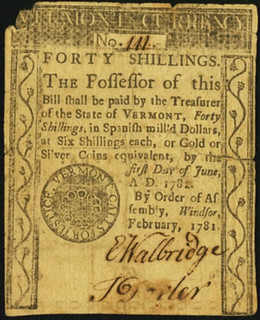

State of Vermont February 1781 40 Shillings Fr. VT-7.
The frail paper, brief period of issue and the fact that only eight denominations were emitted contribute to their rarity. Because many
collectors desire an example for a general typeset, or to add in with their "Thirteen Colonies" sets, the existing 150 or so
known of all denominations tends to be rather spread out. Only the major cabinets, such as the Newman Collection, have had one or more
denominations. Even F.C.C. Boyd did not have a complete eight denomination set.
The series was printed by Judah Spooner and Timothy Green III on very thin, fragile paper that cracked quickly and disintegrated over time. The notes were used for a year, then their legal tender status was revoked; but they continued to be used for paying taxes and were destroyed at the time of payment. The face shows fancy side borders and top border cut. At the lower left is a seal with the motto VERMONT CALLS FOR JUSTICE. The back shows a diamond pattern rectangle forming a cartouche with the imprint and counterfeit warning inside.
To read the complete lot description, see:
http://currency.ha.com/itm/colonial-notes/vermont/state-of-vermont-february-1781-40-shillings-fr-vt-7-pcgs-very-fine-30-apparent/a/241618-86299.s
Lot 86416: D. V. Henry Confederate States Sutler
Sutler issues are always of great interest, and this gallantly titled Confederate Sutler of First Arkansas Mounted Rifles 10 cents note is
likely unique.
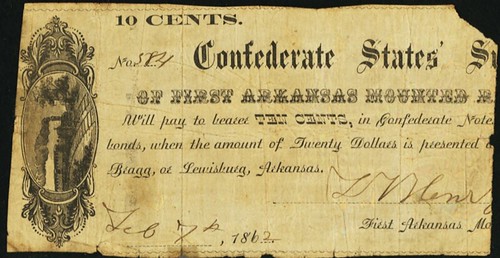
Lewisburg, AR - D. V. Henry Confederate States Sutler of First Arkansas Mounted Rifles 10 Cents Feb. 7, 1862 Rothert 366-1, Keller AR-SA010.
This historic and gallantly titled sutler note is likely unique. Plated in Rothert and Keller, and the missing ten percent of the right end of the note does not diminish its importance. Printed on white paper. Texts and titles are in the right center. The left end panel shows a perpendicular train in oval. Payable in "...[Camp] Bragg or Lewisburg." Most of the signature is visible.
The First was originally formed in Little Rock in June 16, 1861 and was composed of companies A-K. They fought in important, early Western Theatre engagements such as Wilson's Creek, and later in the year were sent to the Indian Territory to engage pro-Union Cherokees. Early in 1862 they were involved in the Battle of Pea Ridge directed by the officers of the Army of the West. The First Arkansas Mounted Rifles was not a Confederate Cavalry unit for long, as they were dismounted by the middle of 1862. There was tremendous reorganization of Confederate forces at that time and Arkansas enlistments were adjusted as well. They fought through the War and eventually surrendered in North Carolina in April 1865 as part of the Army of Tennessee.
To read the complete lot description, see:
http://currency.ha.com/itm/obsoletes-by-state/arkansas/lewisburg-ar-d-v-henry-confederate-states-sutler-of-first-arkansas-mounted-rifles-10-cents-feb-7-1862-rothert-366-1-ke/a/241618-86416.s
Lot 86701: St. Joseph, LA - Parish of Tensas $5 April 4, 1862
In Louisiana, counties are called Parishes. This Parish of Tensas $5 is a choice example with both color and style.
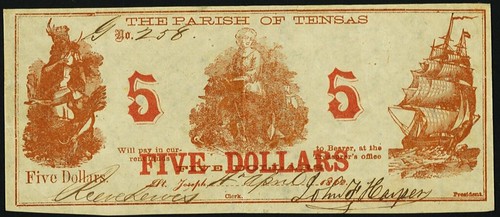
St. Joseph, LA - Parish of Tensas $5 April 4, 1862. PCGS About New 53PPQ.
A Choice example from this scarcer parish note series. Distinctively printed on white paper in brown ink. Like other denominations from the series, it shows a seated allegorical female at the center. At the far left is a Native American princess and kneeling Agriculture. At the far right is a clipper ship. Red protector numerals flank the center vignette, and FIVE DOLLARS is across the bottom center.
To read the complete lot description, see:
http://currency.ha.com/itm/obsoletes-by-state/louisiana/st-joseph-la-parish-of-tensas-5-april-4-1862-pcgs-about-new-53ppq/a/241618-86701.s?ic3=ViewItem-Auction-Open-JumpLot-081514
Lot 86751: Nantucket, MA - Nantucket Bank $3 May 10, 1806
This intriguing Nantucket Bank $3, though a well made false note, is the plate note in The Early Paper Money of America.
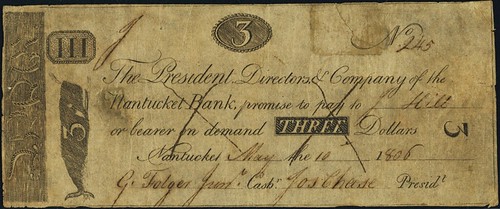
Nantucket, MA - Nantucket Bank $3 May 10, 1806 Contemporary Counterfeit MA-855 C14, Newman Page 220.
A very scarce type listed in The Early Paper Money of America (Fifth Edition), by Eric P. Newman on page 220, where it is the plate note. The early bank was founded in 1795, but had its affairs settled by 1816. We have never encountered a genuine note or a proof from the bank. This type is one of the most intriguing from the early Obsolete note-issuing period.
This note shows a perpendicular, spouting whale on which is a downward-facing "3" balanced by the upward facing "3" at the right end. The end panel at left shows BANK, which looks like it was fashioned from rope. Counters with the number, text, and Roman numerals are on differently shaped, shaded backgrounds. Texts and obligations are across. "Pen Cancelled" with "Tape Repaired Edge Tears." However, this is an iconic type, and the Newman plate note stature adds to its desirability. An essential member of this early banking period's notes.
To read the complete lot description, see:
http://currency.ha.com/itm/obsoletes-by-state/massachusetts/nantucket-ma-nantucket-bank-3-may-10-1806-contemporary-counterfeit-ma-855-c14-newman-page-220-pcgs-very-fine-30-apparen/a/241618-86751.s
Lot 87246: Madison, WI - Bank of Wisconsin $1
Rare Wisonsin proofs from the collection often have relevant vignettes. The Juneau portrait (founder of Milwaukee), patriotic allegory, and
vivid color form powerful combination.
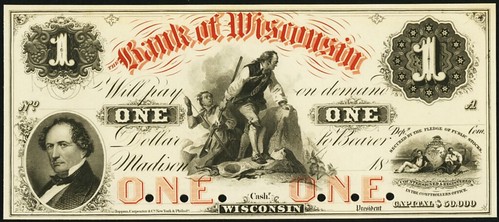
Madison, WI - Bank of Wisconsin $1 18__ WI-400 G2a.
The riveting Bank of Wisconsin vermillion color title series was engraved and printed by Toppan, Carpenter & Co., New York & Philadelphia.
The central vignette shows a Continental soldier, peering down at the British forces, as his companion loads another rifle. At the lower left is a rarely seen portrait of Solomon Juneau, the founder of Milwaukee. The vermillion title arcs over the top and there is a subtle ONE protector across each signature. Hole Punch Cancelled through the India paper and the card. Like all three denominations from this series, it is very beautiful.
To read the complete lot description, see:
http://currency.ha.com/itm/obsoletes-by-state/wisconsin/madison-wi-bank-of-wisconsin-1-18-wi-400-g2a-proof-pcgs-very-choice-new-64/a/241618-87246.s
Lot 87488: $5 1934A Hawaii Federal Reserve Note
This Gem HAWAII $5 emergency note evokes the nation's peril during World War II.
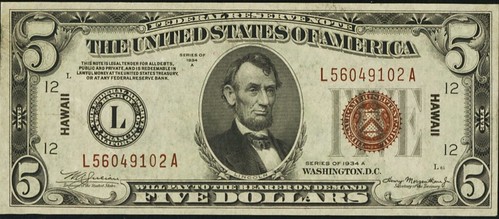
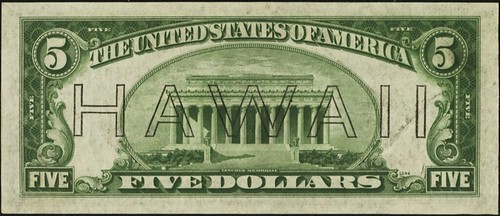
Fr. 2302 $5 1934A Hawaii Federal Reserve Note
Gem Hawaii $5 FRNs are never in large supply. This gorgeous note is sure to garner plenty of attention as the margins are large, the paper quality is excellent, and the colors are quite vivid.
To read the complete lot description, see:
http://currency.ha.com/itm/small-size/world-war-ii-emergency-notes/fr-2302-5-1934a-hawaii-federal-reserve-note-pcgs-gem-new-65ppq/a/241618-87488.s?
The sale closes Wednesday May 4, 2016 starting at 10:00 AM CDT. To place bids, please visit HA.com/241618.
THE BOOK BAZARRE
LUNCHROOM LUNACY: OFFICIALS CALL GENUINE $2 BILL FAKE
I generally avoid publishing counterfeiting stories because they're so common and all tell pretty much the same story. This one is different and deserves the sensational treatment to rebuke the incompetence of the local school officials. -Editor
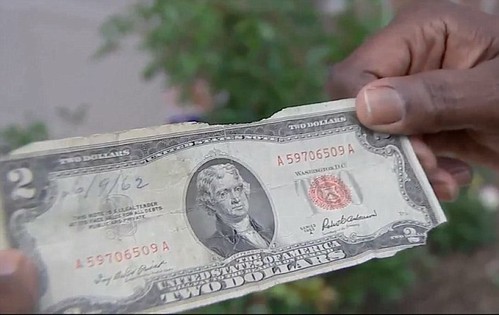
When you think of felony forgery your thoughts might turn to Al Capone or Bonnie and Clyde shooting it out with the Texas Rangers.
Not for some local school cops. For one day, public enemy number one when it came to forgery was 13-year-old eighth grader Danesiah Neal at Fort Bend Independent School District's Christa McAuliffe Middle School.
Now 14, Daneisha was hoping to eat that day's lunch of chicken tenders with her classmates using a $2 bill given to her by her grandmother when she was stopped by the long arm of the law.
"I went to the lunch line and they said my $2 bill was fake," Danesiah told Ted Oberg Investigates. "They gave it to the police. Then they sent me to the police office. A police officer said I could be in big trouble."
Not just big trouble. Third-degree felony trouble.
School officials called Daneisha's grandmother Sharon Kay Joseph.
The officials asked, "'Did you give Danesiah a $2 bill for lunch?' He told me it was fake," she said.
Then the Fort Bend ISD police investigated the $2 bill with the vigor of an episode of Dragnet...
Next stop -- and these are just the facts -- the cop went to a bank to examine the bill.
Finally, the mystery was solved: The $2 bill wasn't a fake at all. It was real.
The bill so old, dating back to 1953, the school's counterfeit pen didn't work on it.
"He brought me my two dollar bill back," Joseph said. He didn't apologize. He should have and the school should have because they pulled Danesiah out of lunch and she didn't eat lunch that day because they took her money."
Joseph said something needs to change so kids don't have felonies looming over their heads for minor crimes -- or actions that aren't even crimes at all.
"It was very outrageous for them to do it," she said. "There was no need for police involvement. They're charging kids like they're adults now."
To read the complete articles, see:
LUNCHROOM LUNACY: COPS INVESTIGATE
$2 BILL SPENT ON SCHOOL LUNCH (http://abc7.com/news/lunchroom-lunacy-cops-investigate-$2-bill-spent-on-school-lunch/1316751/)
Eighth grader sparks counterfeit investigation after she tried to pay for her lunch with a REAL $2 bill from her grandmother
(www.dailymail.co.uk/news/article-3567458/Eighth-grader-sparks-counterfeit-investigation-tried-pay-lunch-REAL-2-bill-grandmother.html)

AMERICAN EUGENICS SOCIETY FITTER FAMILIES MEDALS

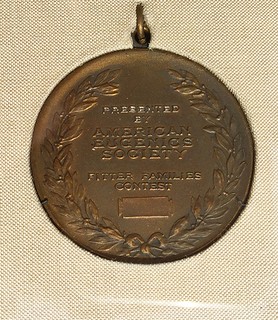
On August 17, 1920, the Topeka Daily Capital reported an exciting development: a new class of competition had been added to the livestock judging categories at the Kansas Free Fair. Class 2.603, part of the Division 203, “Human Stock,” allowed families to submit themselves for judging by the fair's eugenics department. If they were deemed the most pleasing specimens at the fair, they would win the title of “Fitter Family.”
Though the category was new, the judging of humans according to the principles of eugenics wasn't a novel concept in 1920. For at least a decade, state fairs across America had been holding “Better Baby” competitions, in which infants were examined, measured, compared to growth charts, and awarded trophies for good health and genetic superiority. University of Michigan history professor Martin S. Pernick writes that such contests “rivaled livestock breeding and hybrid corn exhibits in popularity.”
Fitter Family competitions, which spread from Kansas across America during the 1920s, were an extension of the Better Babies idea. The advantage of examining older children and adults was that, unlike babies, these specimens could talk back. They also had more life experience for judges to draw upon when making their evaluations.
For every family, representatives from the Eugenics Society of the United States of America would fill out the Fitter Families Examination form. The required details for each family member included their date and place of birth, any serious illnesses, their education, occupation, “physical, mental or temperamental defects,” and “special talents, gifts, tastes, or superior qualities.”
The whole judging process lasted about three-and-a-half hours, and took place in the fair's Eugenics Building. Tacked onto the walls were posters declaring that within three generations, careful breeding could eliminate "unfit human traits" such as feeblemindedness, criminality, pauperism, and epilepsy.
Anyone scoring a B+ or better was given a bronze medal bearing the phrase “Yea, I have a goodly heritage.” This phrase was swiped from Psalm 16:6—the full sentence is, “The lines are fallen unto me in pleasant places; yea, I have a goodly heritage.”
To read the complete article, see:
Here Are the Medals
Given to Eugenically Healthy Humans in the 1920s
(www.atlasobscura.com/articles/here-are-the-medals-given-to-eugenically-healthy-humans-in-the-1920s)
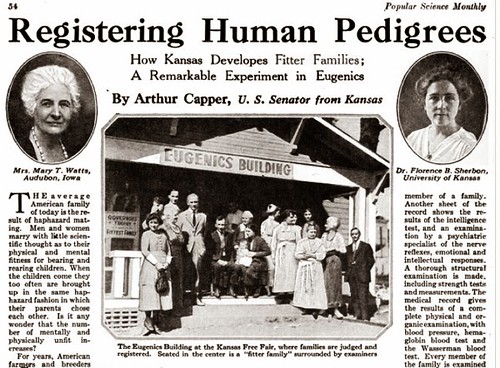
To read the complete article, see:
The Horrifying American Roots of
Nazi Eugenics (http://predicthistunpredictpast.blogspot.com/2014/05/the-horrifying-american-roots-of-nazi.html)
Anyway, the closest numismatic connection we've discussed so far were Laura Gardin Fraser's "Better Baby" medals. -Editor
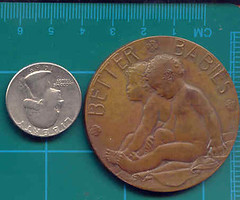
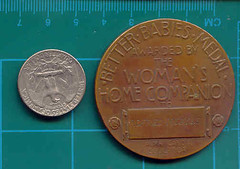
To read the earlier E-Sylum article, see:
LAURA GARDIN FRASER BETTER BABIES MEDAL INFORMATION SOUGHT
www.coinbooks.org/esylum_v10n25a16.html)
THE BOOK BAZARRE
WAYNE'S NUMISMATIC DIARY: MAY 1, 2016
Wednesday, April 27, 2016 started out like nearly every workday, except that a packed bag was stored on the back of my car. After working a little over half a day I ducked out early to head for Dulles airport. Destination: Chicago.
I'd been invited to participate in the Numismatic Editor's Forum at the Central States Numismatic Society show. I was looking forward to it. I never really set out to become an editor, I just fell into it as a part-time task when I started The E-Sylum. it was too much fun, so I just never quit.
After parking my car and shuttling to the terminal I found a Men's Room and entered a handicapped stall to change into some casual clothes. It had one of those automatic toilets, so every time I moved an elbow or knee the toilet flushed. When I emerged the room was deserted - they may have hightailed it, understandably thinking I was an Ebola victim fresh off a flight from Ghana.
My United flight was blissfully uneventful until our landing in Chicago. BAM! While we were all still digesting what we'd heard and felt, there was another BAM! It was our landing gear hitting hard. But all was well, thankfully.
I caught a cab to the Renaissance Schaumburg Convention Center hotel and checked into my room. The staff was very friendly and helpful, and my room was great. Laid out like a Grand Hyatt, the hotel had a huge central atrium.
After unpacking some things I went downstairs looking for some casual snack food in the bar. I quickly ran into Pete Smith, who was just finishing a meal. We then grabbed seats at the end of the bar to catch up.
I passed on the Fried Bologna sandwich, which sounded like a heart attack waiting to happen. I ordered the tacos, but I thought they tasted horrible. The bartender let me reorder, and I got a small pizza this time. Not so healthy either, but at least what I ate of it was tasty.
Topics with Pete included families and work, and Pete's newest project. He'd codenamed it project G.R.O.S.S., which stands for "Getting Rid of Some Stuff". God bless him. We collectors can accumulate inordinate amounts of stuff, especially bibliophiles. We talked about venues and strategies for selling and donating coins and numismatic literature.
I was nursing a single-malt scotch through all of this, and it was good. Usually the only drinks I have in the course of a month are some wine at our Nummis Nova social group dinners.
Eventually it was time to split up; I paid my tab and headed to my room, where I ironed a shirt and watched the Robert Redford baseball movie The Natural on TV. It was a nice evening away from working on The E-Sylum.
But I didn't slack off for long - I got up at 5:30 Thursday morning and worked on articles from Harvey Stack, Robert Hoge and others. I went downstairs for breakfast and ordered the buffet. it was a good choice. There was a great stock of fresh hot and cold food. I'm usually a cereal eater but I indulged with some good sausage, crisp bacon and delicious roasted potatoes. Cooked with onions and peppers, they were quite tasty, although I came to realize that they weren't potatoes so much as a butter delivery mechanism - not a good everyday choice. But this was one of the best hotel breakfasts I'd ever had.
Back up at my room I got back to work on The E-Sylum and also made a phone call to sort out a credit card matter for my wife. At 9:30 I showered and got dressed, and by 10 was heading over to the convention center side of the complex.
Editor's Forum
I quickly found the room where the Editors Forum would be held, and Beth Deisher was already there. We talked a while about our preparations and discussion topics, as well as the Newman Numismatic Portal. Steve Roach soon arrived and joined us.
I excused myself to go get a drink of water and soon ran into our fourth panelist, David Harper of Numismatic News, and led him back to the Forum room. Attendees were already getting seated, and David Lisot was setting up his video equipment.
While we were waiting to start I briefly spoke with Gerry Tebben, Bruce Perdue and David Lisot. After Gerry kicked things off Beth talked from a PowerPoint deck she'd prepared, giving some very good advice on understanding your audience, soliciting articles, and easy-to-use newsletter templates.
In my own opening remarks I emphasized that the Editor's task doesn't have to be a lonely one. I get by every day with a little help from my friends, and I gave this example. A couple weeks ago, I excerpted John Kraljevich's Introduction to the Stack's Bowers Pogue Four catalog, where he noted how useful the Newman Numismatic Portal was to his work as a cataloguer.
I remembered something pertinent that Joel Orosz once said to me about the Portal, and I dashed off a note asking if he would send me a few sentences for an upcoming issue (that's step 1). He did. Now for step 2: I tried to envision how this would look in the issue.
The article was about three eras of numismatic research - pre-internet, internet, and the Newman Portal era. I pictured section headers, each with an appropriate image illustrating the era. So what would the images be? One was easy - the Newman Portal logo. For the pre-internet days, I picked a random image of a bookshelf. For the pre-NNP internet, it turned out I already had a funny image of an old man at an old-fashioned personal computer. I added a fourth section where I discussed future eras, and found a rainbow picture I thought was appropriate. As my old friend Ken Lowe would say, badda-bing, badda-boom - done.
I could have written it myself from scratch, but with Joel's help we had a much better article, much faster. His part didn't take too long to complete, and neither did mine. Many hands make light work.
My other advice for my fellow editors was to take advantage of their unique perspectives and vantage points. By dint of geography, or simple personal relationships, there are always opportunities for interesting articles, if only one thinks to ask. Hook up with curators at a local museum or historical society and highlight numismatic connections. You can do all of this easier and faster than people outside your location or numismatic specialty.
Finally, I told them not to be afraid to borrow material from elsewhere. This is getting easier and easier to do with online archives like the Newman Portal. Search around and find an earlier article that would be of interest to your readers today. Get permission if necessary, but cut, paste and bingo - a new article. Don't beat youself up for being lazy - you add value by curation and perspective. Your editor's eye chooses that one item of hundreds on behalf of your readers, and your comments add value for newer collectors who may not be familiar with the material. Your readers will appreciate your work, and you may find that it generates new discussion on the topic. This happens every week in The E-Sylum.
I won't recap here everything that was said, but it was a very useful and productive event. David Lisot captured it all on video, so it will be avalable in the future.
Here are some photos taken by Bruce Perdue. Thanks!
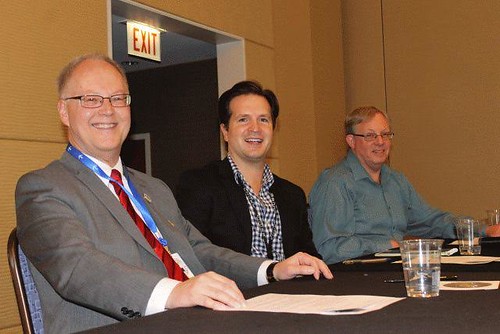
David Harper, Steve Roach, Wayne Homren

Beth Deisher, David Harper, Steve Roach, Wayne Homren on dias
David Lisot Manning video equipment, Gerry Tebben at podium
Bourse Floor
Bruce Perdue and I next walked downstairs to the bourse floor where I met Bourse Chairman and baseball fan Kevin Foley, who gushed over
The E-Sylum, comparing it to the 1950 New York Yankees.
I also spoke for a bit with Julian Leidman, Elongated Cent man Ray Dillard and waved to Paul Cunningham. I took this shot of some great plaques at Paul's table.
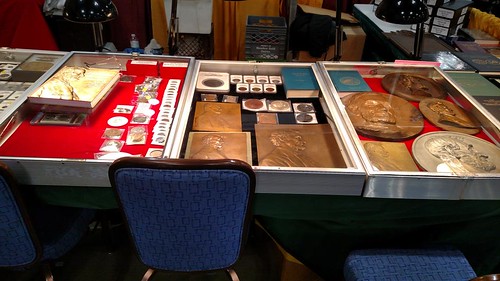
Next I visited Dave Lange at the NGC booth. As promised he had a few copies of his new book on hand.

Next I spoke to Darrell Luedtke, editor of the wooden money journal Bunyan's Chips.
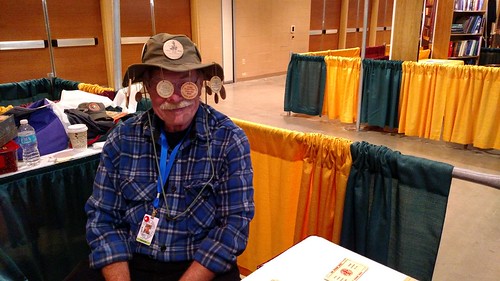
Darrell Luedtke wearing a wooden nickel collector's hat

Darrell at the Wooden Money Table, sans hat
Exhibits
While wandering the bourse floor I took some time to review the exhibit area, which was quite extensive, rivaling the annual American
Numismatic Association convention. Here are some pictures of exhibits that caught my eye.
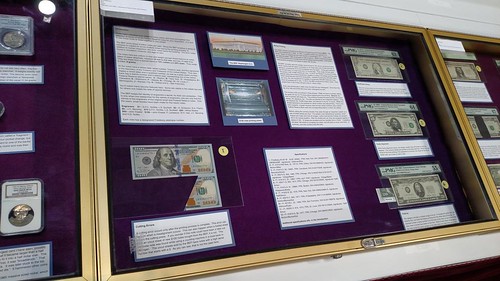
Paper Money Errors
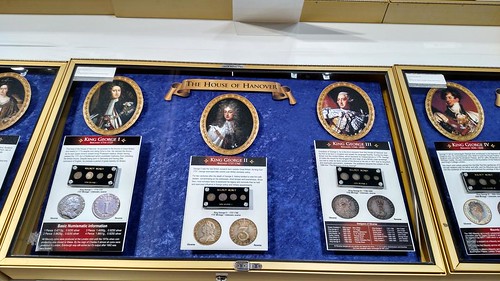
Maundy Coinage
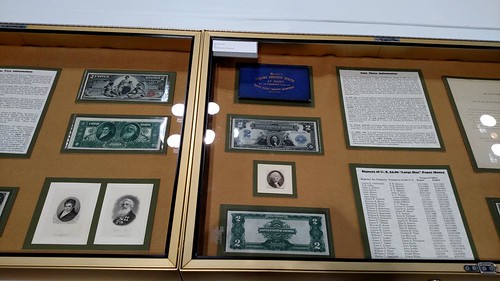
Paper Money. Note the Small Heath's Counterfeit Detector
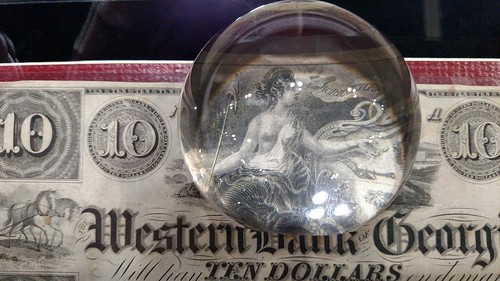
Georgia's Risque Vignettes
The Newman Numismatic Portal
By now E-Sylum readers are familiar with the Newman Numismatic Portal. Len Augsburger and I gave a talk to a couple dozen attendees.
I started off with comments about Why the Portal is necessary, and len took over to discuss the What and the How. We had some great
questions from the audience.
Afterwards I enjoyed meeting some of the attendees, including Kathy Freeland of TAMS and E-Sylum contributor Harry Waterson, whom I'd never before met in person. Coin shows are great for nothing if not putting faces to names.
Back On the Bourse Floor
After the NNP meeting I went back down to the bourse floor for a while. I visited with Ed Krivoniak and Pat McBride at the Burns library
booth. Pat has done a marvelous job creating a welcoming and colorful layout for the Burns and PAN booths.
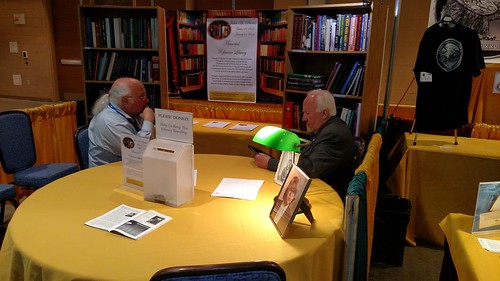
Ed Krivoniak and Pat McBride
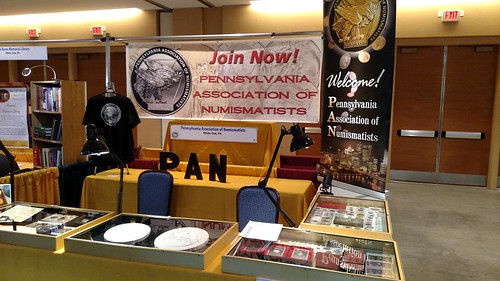
Pennsylvania Association of Numismatists Booth
The lots in the upcoming PAN online auction (closing May 6th) were at the table for viewing. Pat showed me an interesting book lot: A Guide to the Coins of Great Britain & Ireland with embossed & colored plates.
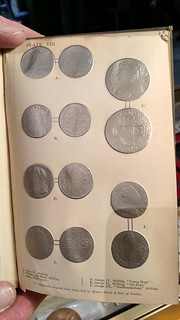
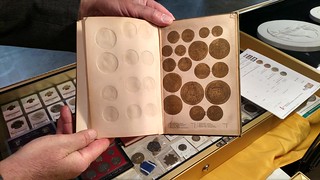
To read the complete lot description, see:
A Guide to the Coins of Great
Britain & Ireland (www.go2coinauctions.com/Listing/Details/831835/A-Guide-to-the-Coins-of-Great-Britain-Ireland)
Brad Karoleff snuck up behind me and grabbed my backpack, moving around so I couldn't see him, try as I might. I had no idea who it was.
My time was running short, so I said my goodbyes and headed to the lobby to pick up my bag and head out to my waiting cab. That breakfast had lasted me all day and I never did eat lunch. Luckily I had time to grab dinner at the airport before my flight. It was whirlwind trip, but very productive and enjoyable. Great show!

HUGE ROMAN COIN HOARD UNCOVERED IN SPAIN
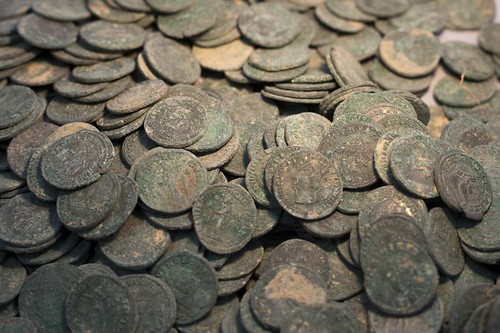


To read the complete article, see:
El tesoro de las monedas romanas de
Tomares (http://elpais.com/elpais/2016/04/28/album/1461842532_
524900.html#1461842532_524900_1461846372)
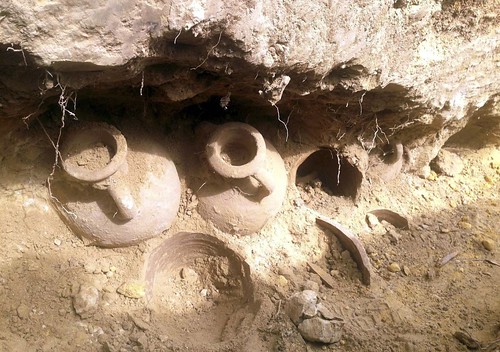
To read the complete article, see:
600 kilos de monedas romanas descubiertas en
Tomares (Sevilla) (http://cultura.elpais.com/cultura/2016/04/28/actualidad/1461825424_636184.html)
Construction workers laying pipes in a park in southern Spain have unearthed a 600kg trove of Roman coins. The bronze coins dating from the late 4th Century were found inside 19 Roman amphoras, a type of jar. They bear images of the emperors Constantine and Maximian and it is thought they may have been used to pay soldiers or civil servants.
The Director of the Seville Archaeological Museum Ana Navarro said the discovery had incalculable value. "It is a unique collection and there are very few similar cases," she said.
"I could not give you an economic value, because the value they really have is historical and you can't calculate that."
Work on the pipes, in the town of Tomares, has been suspended while an archaeological survey is carried out. The Romans began to conquer Spain in 218 BC, ruling until the 5th Century.
To read the complete article, see:
Spanish pipe-layers find large Roman coin hoard
(www.bbc.com/news/world-europe-36172538)
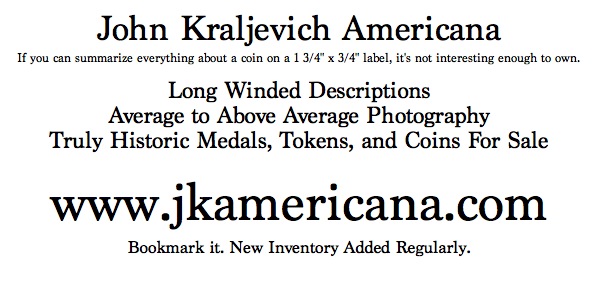
THE R. J. REYNOLDS JOSHUA COIN
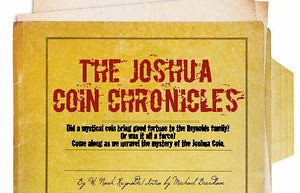 Legend has it that when R. J. Reynolds rode into Winston-Salem in 1875 to found the R. J. Reynolds Tobacco Company, he had $500 and a sack
of tobacco seeds in his saddlebag. What most people don't know is that he also carried a lucky family coin with him—the Joshua Coin— that had
originally belonged to his Irish great-grandfather Joshua Cox. Square in shape and silver in color, the totem was thought to be an ancient Peruvian
coin that brought protection and good luck to its owner.
Legend has it that when R. J. Reynolds rode into Winston-Salem in 1875 to found the R. J. Reynolds Tobacco Company, he had $500 and a sack
of tobacco seeds in his saddlebag. What most people don't know is that he also carried a lucky family coin with him—the Joshua Coin— that had
originally belonged to his Irish great-grandfather Joshua Cox. Square in shape and silver in color, the totem was thought to be an ancient Peruvian
coin that brought protection and good luck to its owner.
Stories about the coin started spreading locally in the early 1900s as Reynolds began amassing incredible wealth. Not only was the totem credited for providing his family with great fortune, it was also said to protect all those who wore it or shared its luck from harm's way. For a time, the coin was passed down through generations of Reynolds. But at some point, it mysteriously disappeared, causing it to spiral into one of Winston-Salem's most mystifying tales.
Some say the coin was nothing special, simply a piece of silver with no magical powers. Others say it was more of a curse than a blessing, causing both triumphs and tragedies. Some even speculate the coin wasn't Peruvian at all, but was actually one of the original 30 pieces of silver given to Judas for betraying Jesus.
All of this leads toward a tale with lots of questions and not a lot of answers. So, in an effort to explore the coin in more detail, we turned to Noah Reynolds for help. Not only is Noah the great-grandson of R.J. Reynolds, but he is also a coin collector and family historian who's done extensive research on the coin and its history to separate fact from fiction. According to him, to understand the full story of the Joshua Coin, you've got to go back in time nearly 300 years—back to a man named Joshua Cox. We'll let Noah take it from here…
To read the complete article, see:
The
Joshua Coin Chronicles
(http://m.journalnow.com/winstonsalemmonthly/the-joshua-coin-chronicles/article_3982b892-0aed-11e6-bf26-67cd8411cfa1.html?mode=jqm)
HOW HOWARD DANIEL GOT MPCS WHOLESALE
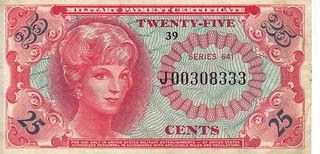 I was going through my "black hole" library today and found a reference which lists the name of the dealer I sent all of my MPCs
to during the Vietnam War from January 1966 to January 1973. It is Jim Wilson's House of Hobbies, Minong, WI 54859! I had forgotten about
him.
I was going through my "black hole" library today and found a reference which lists the name of the dealer I sent all of my MPCs
to during the Vietnam War from January 1966 to January 1973. It is Jim Wilson's House of Hobbies, Minong, WI 54859! I had forgotten about
him.
Whenever there was a change to a new MPC series, I would visit my favorite bar in Saigon and look through the owner's stash of "worthless" old series notes. I would pick out the AU and better notes and pay her 10 Cents on the dollar. I would first set aside the replacements and notes I needed for my collection, then create several envelopes for what I sent to Mr. Wilson. I sent him hundreds of notes and he bought them at 10% over face! So many of the high grade MPCs that you have seen are from Jim Wilson selling them. His checks went to my bank account at the National Bank of Fort Lauderdale and not back to me in Vietnam.
I was also often the Pay NCO with a Pay Officer and I got a bunch of notes in my wallet ready to exchange for replacements when I saw them. I saw VERY few of them but I got all of them still in my collection.
Fred Schwan thinks I was breaking a regulation by mailing the "old" MPC back to the USA and selling it. Before I sent back my first envelope to Mr. Wilson, I visited the MACV Hqs JAG office and talked to a JAG officer about it. He told me that on "C Day", the old series became scrap paper and I could do anything I wanted to do with it.
I also bought many MPCs while I was back in Vietnam from 1989. In those early years back there, MPCs were all less than a US$ a piece. There were sometimes suitcases of them sitting in a shop and they included the VOID and/or Evidence MPCs, which I bought! But by the mid-1990s, the suitcases no longer appeared in the shops.
Hope you like this background information to many MPCs being in the USA and elsewhere because of what I did after "C Days" during my six years there and for five or six years from 1989.
The Master Sergeant Daniel
To read the complete issue, see:
MPC GRAM SERIES 11 No.2307 25 APRIL
2016 Fest XVII Report Part 2 (http://us13.campaign-archive1.com/?u=10eb366ab80344a56657e0d5d&id=2a83aa7f69&e=f71a788d6b)
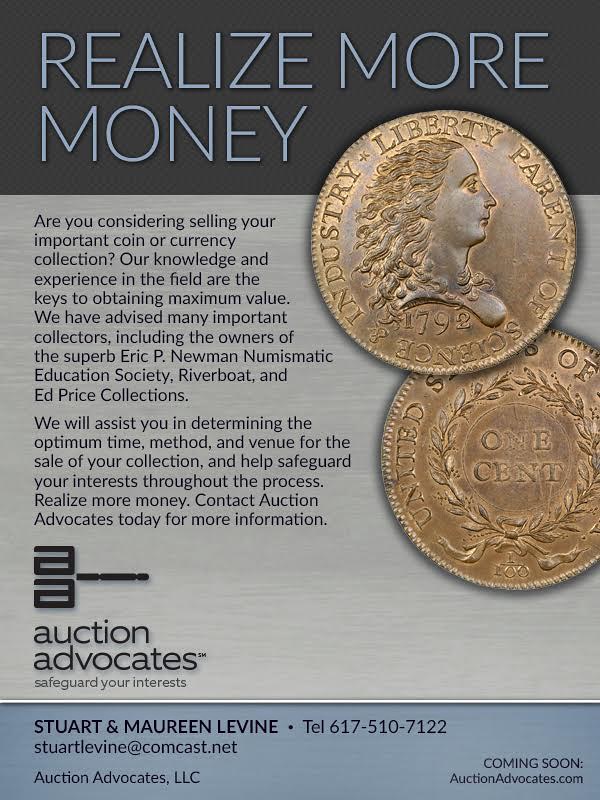
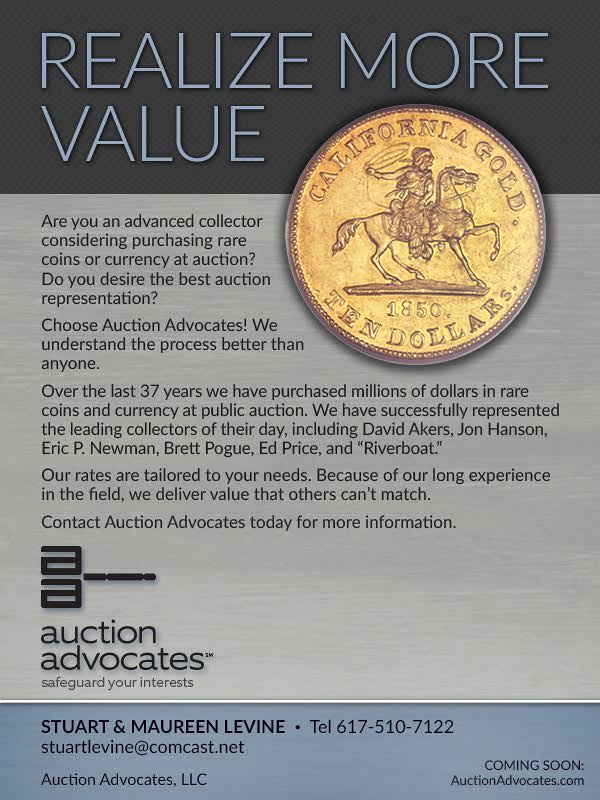
ENGLAND'S £20 NOTE TO FEATURE ARTIST JMW TURNER
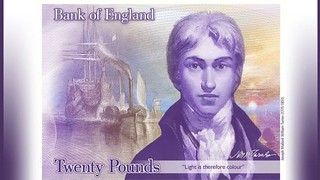 Artist JMW Turner and his painting The Fighting Temeraire will feature on the new design of the Bank of England's £20 note to enter
circulation in 2020.
Artist JMW Turner and his painting The Fighting Temeraire will feature on the new design of the Bank of England's £20 note to enter
circulation in 2020.
The English Romantic artist was chosen from a list of public nominations - the first time the Bank has asked who should appear on a specific banknote.
The note, to be made of polymer, will eventually replace the current £20 note featuring the economist Adam Smith. The choice means all but one Bank of England banknote character will be men.
Of the five characters on banknotes by 2020, other than the Queen only Jane Austen - appearing on the £10 note from 2017 - is a woman.
The men who will feature by 2020 are Sir Winston Churchill on the £5 note who will replace campaigner Elizabeth Fry from September, Turner on the £20 note, and Matthew Boulton and James Watt remain on the £50 note.
The Bank received 29,701 nominations from the public after it announced it wanted to celebrate an artist on the note. Some 590 eligible visual artists were considered for the honour - about a fifth of whom are women.
The committee drew up a shortlist of five - Turner, filmmaker Charlie Chaplin, sculptor Barbara Hepworth, painter William Hogarth, and designer Josiah Wedgwood. The final decision was made by the Bank's governor, Mark Carney.
He said diversity was a consideration in the decision, and he admitted that "further progress" was needed on all measures of diversity when thinking about representation on banknotes. However, he said the process was more transparent and independent now.
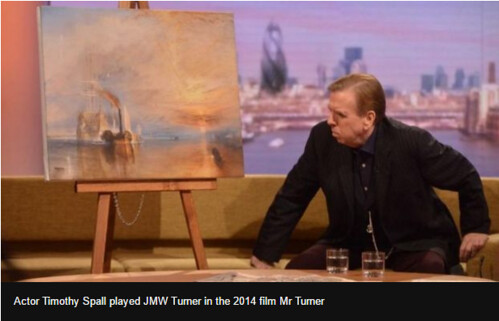
Joseph Mallord William Turner, or JMW Turner (1775 - 1851), is known as "the painter of light" and described by artist Tracey Emin as a "wild maverick".
To read the complete article, see:
New £20 note design and personality unveiled by Bank of England
(www.bbc.com/news/business-36111975)
THE BOOK BAZARRE
ARCHIVES INTERNATIONAL APRIL 2016 SALES RESULTS
RARE CHINESE FOREIGN BANKNOTE – A DEUTSCH-ASIATISCHE BANK, 1907 PEKING ISSUE BANKNOTE RARITY – BRINGS A RECORD $30,000 AT ARCHIVES INTERNATIONAL AUCTIONS
The auction was held April 11 th , 12 th and 13 th at Archives International Auctions' offices in Fort Lee, N.J., featuring Part 3 of the Alexander I. Pogrebetsky family archives of rare Chinese and Asian banknotes, and the first offering from the Silicon Valley collection of worldwide banknotes

907 Peking issue 5 Taels banknote
A high-grade Deutsch-Asiatische Bank, 1907 Peking issue 5 Taels banknote rarity soared to a record $30,000, after opening on the floor for $14,500, at a three-day auction held April 11-13 by Archives International Auctions, in the firm's offices at 1580 Lemoine Avenue (Suite 7) in Fort Lee. Additional Chinese and Russian banknote rarities also posted new world record prices.
“The success of this auction, with specific regard to the many Chinese, Asian and Russian banknotes that set new price records, clearly proved that the banknote and coin market in these areas is as active and vibrant as ever, with multiple buyers across the globe and aggressive competition for rare and unique items,” said Dr. Robert Schwartz, President of Archives International Auctions.
Over 1,700 lots of United States, Chinese, Russian and worldwide banknotes, coins, scripophily (stocks and bonds) and security printing ephemera were offered over the course of the three days. Featured were additional banknotes from the Alexander I. Pogrebetsky family archives of rare Chinese and Asian banknotes, and the initial offering from the Silicon Valley collection of worldwide banknotes.
Session 1, on April 11 th , featured U.S. and worldwide banknotes and scripophily. Session 2, on April 12 th , contained Russian and worldwide banknotes and Chinese scripophily. Session 3, on April 13 th , featured Chinese banknotes and scrip notes. Nearly all the Chinese and Russian notes were from longstanding collections assembled over many decades and never previously offered.
Session I, began with world banknotes, featuring the Silicon Valley collection and numerous consignors banknotes. French Colonial notes were big hits and included a French Guiana, 1961, 500 Francs graded Gem Unc. 65 that sold for $1,140; and 1 Rupee, 1957 and 5 Rupees, 1959, Government of India “Persian Gulf Note” issues that brought for $885 and $3,540, respectively;
Also sold was a Jordan Currency Board, 1952 Issue, 500 Fils with special serial # B/A 700007 that gaveled for $1,770; a rare Oman Currency Board specimen set of eight denominations in Choice AU to Gem Uncirculated condition, rarely seen in this format, that realized $6,000; and an unassuming lot of Chile banknote rarities that had been cut in half achieved an amazing $5,400.
Session II began with worldwide banknotes from Pacific Rim and Asian countries. Highlights included 25 Rupiah and 50 Rupiah essay specimens by Security Bank Note Company that rose to $1,140 and $1,020, respectively; a Japan, 1 Yen Coiled Dragon Silver Dollar, M34 (1901) in MS 65 ($708); and a Royal Thai Mint Double Coin presentation set, circa 1944 to 1963 (also $708).
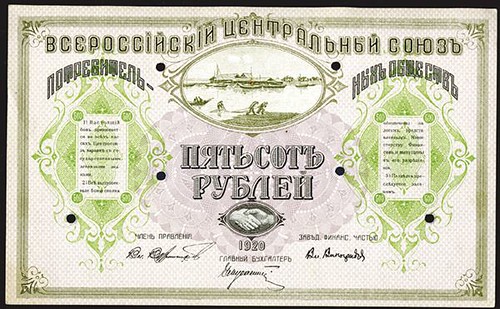
1920 All Russian Central Union of Consumer Societies Specimen
In addition, 101 lots of Chinese railroad and related bonds were sold out of the 102 lots offered, with most lots bringing $250-$500. Russian notes included two Vladikavkaz Railroad Co., 1918, 5,000 and 10,000 Rubles notes that sold for $885 and $944, respectively; a 1920, 500 Rubles, Russian Central Union of Consumers Societies Specimen ($4,427); and a circa 1918-20 Torgsin Soviet Trading Fleet 3 Rubles Scrip Note that ended up selling for a very impressive $11,400.
Session III highlights of Chinese banknotes and scrip notes included eight different Imperial Ch'ing Dynasty banknotes, including a 100,000 Cash, 1858 ($11,400); and a pair of 3 Taels and 5 Taels Board of Revenue banknotes that finished at $4,800 and $5,605, respectively. Also, a group of Alexander I. Pogrebetsky banknotes used as the photographic examples on the matching pages from his 1929 numismatic book hammered for between $620 and $4,720.
A Central Bank of China, 1949 5,000 Gold Chin Yuan essay specimen by Security Bank Note Company breezed to $3,658; while a 1923 National Commercial Bank, Ltd., issue pair gaveled for $1,475. People's Republic issues were highlighted by a 1949, 5 Yuan, P-14a high grade example that went for an impressive $6,000 after intense bidding between the floor and internet.
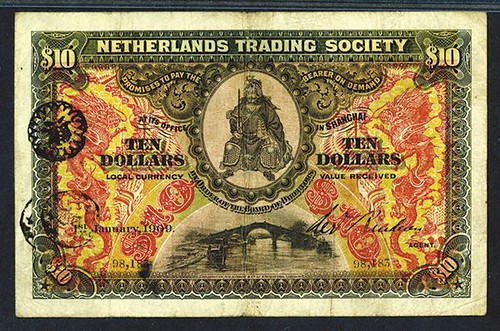
1909 Netherlands Trading Society banknote
Chinese foreign banks featured a Netherlands Trading Society, $10, 1909 issue note ($4,800); and a Peiyang Tientsin Bank, 3 Taels, 1910 issue ($8,075). Chinese scrip notes featured a large collection of Harbin notes, highlighted by a circa 1920-30's banknote pair from Harbin Bakery ($3,186); a Society of Artisans Club, 1919 Harbin issue ($6,300); and a Hulunbeier Business Bank, 1919 scrip note ($3,120).
Archives International Auctions is always looking for U.S. and worldwide banknotes, coins, stocks, bonds, stamps, postal history, autographs and historic ephemera and documents for future auctions, or to buy outright. To sell or consign one piece or an entire collection, you may call AIA at (201) 944-4800; or you can send them an e-mail to info@archivesinternational.com.
You may also write to Archives International Auctions, at 1580 Lemoine Ave., Suite #7, Fort Lee, NJ 07024 U.S.A. To learn more about Archives International Auctions and their upcoming summer and fall auctions, log on to www.ArchivesInternational.com. Updates are posted often.
MALAYSIAN COLLECTORS QUEUE UP FOR COMMEMORATIVES
AFTER waiting for five hours amid the heatwave, an avid collector walked away all smiles with a set of commemorative coins in his possession.
The coins were recently launched by Bank Negara Malaysia to mark the 70th anniversary of Radio Televisyen Malaysia (RTM).
Koay Cheng San, 66, who had been collecting coins for the past 30 years, turned up at the bank's Penang branch in Light Street, George Town, at about 5am.
He said there were already eight people waiting in queue even though the bank only opened at 8.45am.
“I managed to get my hands on 10 Nordic gold brilliant uncirculated coins with a face value of RM1 for RM10.60 each.
“I also got a RM10 silver commemorative coin for RM212. I am sure this coin can fetch up to RM600 in the near future,” said the elated pensioner.
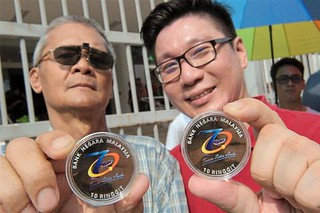 Koay revealed that he had wanted to buy another set later, but the coins were already sold out by then.
Koay revealed that he had wanted to buy another set later, but the coins were already sold out by then.
Another passionate coin collector, Ong Joe Sin, 13, came all the way from Bukit Mertajam and waited for almost four hours.
“I've been collecting coins since nine as I find them very interesting and valuable. I bought these commemorative coins using my own savings,” he said.
The silver and Nordic gold brilliant uncirculated commemorative coins are limited to only 500 and 10,000 pieces respectively.
The coins, also available in a set of two, are limited to 2,000 sets. It has the iconic image of RTM's headquarters, Angkasapuri, which has a unique facade decorated with a motif based on the shape of the tongue.
To read the complete article, see:
Collectors
brave hot spell to queue up for special coins
(www.thestar.com.my/metro/community/2016/04/26/for-their-hobbys-sake-collectors-brave-hot-spell-to-queue-up-for-special-coins/)

CLASSICAL NUMISMATIC GROUP SALE 102
Classical Numismatic Group is proud to present CNG 102, an Internet and Mail Bid Sale closing electronically on Wednesday, 18 May 2016, from 10 AM ET (U.S.). This sale offers 1571 lots with a presale estimate in excess of $2,900,000.
Our annual spring sale features Greek, Celtic, Oriental Greek, Central Asian, Roman Provincial, Republican, and Imperial coinage. Additionally, there are featured selections of Byzantine, Early Medieval, Islamic, World, World Medals, British, and British Medals.
General selections of coins are included throughout the sale from the estate of Thomas Bentley Cederlind and the collection of J. Eric Engstrom.
The Greek section is also highlighted by coins from the named collections of Allan Smith M.D., Byron Schieber, M.A. Armstrong, Colin E. Pitchfork, and Dr. Will Gordon. In addition, there are selections of fractions from the AG collection and electrum from the LVL collection. Many of these coins enjoy earlier pedigrees. The Oriental Greek section includes an offering of 20 Parthian tetradrachms and several important pieces of Baktrian gold.
In the Republican and Imperial section, one will find offerings from the Volteia, Schieber, and LVL collections in addition to coins from Cederlind and Engstrom. The Imperial section offers over 90 Roman aurei and a nice selection of Roman bronzes, many from the Cederlind estate. Tom took great pride in the bronzes he had in inventory, as all are free from many of the problems one normally encounters with bronzes on the market today.
The Byzantine section offers coins from the M.A. Armstrong collection, which includes a number of Sear Byzantine Coins and Their Values plate coins. The early Medieval section is highlighted by coins from the R.D. Frederick Collection and the Cederlind estate, while the World section includes further selections from Engstrom, Cederlind, and Group SGF. Of special note is a nice selection of Viking related coinage that can be found under Denmark and Sweden.
CNG 102 features a strong selection of English coinage. This section is comprised of 160 lots, and includes coins from the Cederlind estate, the R.D. Frederick, Dr. Andrew Wayne, and LVL collections. Included from Dr. Wayne are a number of rare Saxon mints, and the LVL offering consists of 19 pieces of Scottish gold.
The World and British sections conclude with offering of medals that include several rare Dutch pieces in gold and the Eimer plate coin for the Charles I, Dominion of the Sea medal.
This well-rounded sale offers something for everyone. Catalogs have been mailed to our active mailing list and bidding is open on the site.
Some of the individual highlights from CNG 102 are:
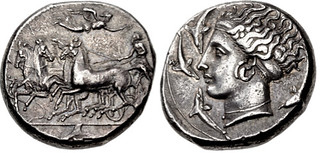
LOT 155–SICILY, Syracuse. Dionysios I. 405-367 BC. AR Tetradrachm (25.5mm, 17.22 g, 3h). In the style of Eukleidas. Struck circa 405-400 BC. Charioteer, holding kentron in right hand and reins in both, driving fast quadriga left; above, Nike flying right, crowning charioteer with wreath held in both hands; in exergue, dolphin right / Head of Arethousa left, hair in band, wearing double-loop earring and plain necklace with frontal pendant; [Σ-Y-PAK- O-ΣI-ΩN above hair], four dolphins around. Tudeer 104 (dies 35/71); HGC 2, 1345; SNG ANS 300; BMC 197; Boston MFA 444; Jameson 809; de Luynes 1208; Rizzo pl. XXXXVIII, 16 (all from the same dies). Near EF, attractive cabinet tone, reverse a touch off center. Estimated at $5,000.
From the Allan Smith, M.D. Collection. Ex Gorny & Mosch 190 (11 October 2010), lot 67; Gorny & Mosch 112 (17 October 2001), lot 4036; Peter M. Suter Collection (Münzen und Medaillen AG 89, 14 June 2000), lot 83; Münzen und Medaillen AG 66 (22 October 1984), lot 43.
Arguments for Daimon and for Mithraic Areimanios
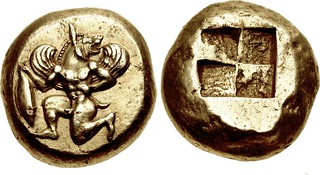
LOT 366–MYSIA, Kyzikos. Circa 550-500 BC. EL Stater (18mm, 15.87 g). Winged male mythological creature running-kneeling left, head right, holding tunny by its tail in left hand / Quadripartite incuse square. Von Fritze I 123; Greenwell 57; SNG France 271; Boston MFA 1457 = Warren 1471; SNG von Aulock 1198 = Kraay & Hirmer 704 = L. Mildenberg, “Über das Münzwesen im Reich der Achämeniden” in AMI 26 (1993), pl. VII, 62; Gulbenkian 617; Jameson 2560; Weber –. Near EF, lightly toned. Well-centered, struck from artistic dies. Very rare and exceptional for issue. Estimated at $50,000.
From the LVL Collection.
While the identification of this creature, certainly of local significance, is unknown today, it has traditionally been referred to as “Phobos” or “Daimon.” In his catalog of the Gulbenkian collection, Jenkins sees an Egyptian or near-Eastern influence, while Bivar, in his article on Mithra (“Mithra and Mesopotamia,” Mithraic Studies [Manchester, 1975], pp. 275-89), suggests that the creature corresponds to the Mithraic Areimanios (Ahriman). One also may see an assimilation of the ubiquitous Persian lion-headed griffin, adapting the head, wings, and tail to a human body. Although some references note the head as being that of a wolf, other examples clearly show a mane that is directly influenced by the lion heads on the common early Lydian electrum, supporting Bivar's (and others') contention that it is a lion head. At the same time, the ear is not fully visible on most examples, but on some, such as the present piece, it clearly is that of a griffin (compare to its depiction on the coins of Teos and Abdera). The wings and posture of the creature are mythological archetypes, commonly found on displays of various deities and creatures on pottery and coins. An excellent example of an archaic representation of a local deity of Asia Minor.
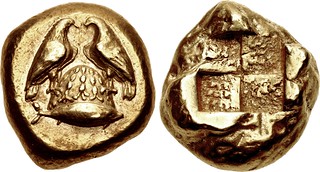
LOT 378–MYSIA, Kyzikos. 5th-4th centuries BC. EL Stater (16.5mm, 16.03 g). Two eagles standing facing each other on ornamented omphalos; below, tunny right / Quadripartite incuse square. Von Fritze I 220; Greenwell 22; SNG France 348; Boston MFA 1535 = Warren 1440. Near EF. Rare. Estimated at $20,000.
From the LVL Collection.
This rare type depicts the legend of the omphalos (navel) stone, which marked the sacred precinct of the sanctuary of Apollo at Delphi as the physical center of the earth. According to tradition, two eagles, which had been released by Zeus, one flying from the east, and the other from the west, met exactly at the site of Apollo's sanctuary. This spot was marked for all to see by the stone omphalos, and designated as the center of the earth. The omphalos was a white stone ornamented with stripes of various kinds, and upon it were the representations of the two eagles (as seen on this coin type – the tunny fish below is the city-badge of Kyzikos). This scene was frequently represented in vase-paintings, but is extremely rare on coinage. The omphalos probably stood on the sacred hearth that was in the center of the temple.
The origins of Apollo's temple at Delphi are described in the Homeric Hymn to Apollo. Apollo descended from Mt. Olympos and made his way through northern and central Greece until he finally found the proper site for the foundation of his oracle at Crisa under the snow-capped Mt. Parnassos. He laid out his temple and then slew a she-dragon, which inhabited the area. The name of the site was subsequently called Pytho (and Apollo, the Pythian) due to the rotting body of the slain dragon. (The verb pytho, in Greek, means ‘to rot'.) Interestingly enough, Zeus punished Apollo for the murder of the dragon by exiling him to Thessaly for nine years. A religious festival called the Stepteria was celebrated every ninth year at Delphi to commemorate these events associated with the foundation myth of the sanctuary.
After Apollo established his sanctuary, he went about the business of recruiting attendants for the temple. He noticed a ship passing by, manned by Cretans from Knossos, and on their way to Pylos. Apollo transformed himself into a dolphin (δελφις, hence the name of the city) and leaped aboard the Cretan ship. At first the men tried to throw the dolphin back into the sea, but they were “awed” by it into a “fearful submission”. After a lengthy voyage, Apollo led the ship to Crisa, where “he leaped ashore and revealed himself as a god amid a blaze of fiery brightness and splendor”. He ordered the Cretan men to perform sacrifices and to pray to him as Apollo Delphinius. He then led them to his sanctuary and placed the Cretans in charge, predicting great wealth and prestige for his temple.
This story linked the early cult of Apollo to Crete and promoted Apollo as the god of sailors and colonization. His oracle at Delphi played a major role as the religious impetus for the Greeks in establishing their colonies, hence its importance to the residents of Kyzikos, itself a colony of Miletos. The importance of this coin type to Kyzikos may also be found in another story that has the city being settled by the Pelasgi from Thessaly, who were driven from Thessaly by the Aeolians. Their king and leader was Kyzikos, a son of Apollo, who gave his name to the city and thus established its link to Apollo and his temple at Delphi.
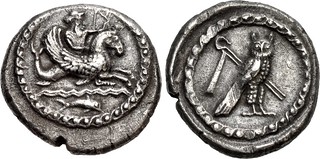
LOT 628–PHOENICIA, Tyre. Uncertain king. Circa 425-394 BC. AR Quarter Shekel (15.5mm, 2.90 g, 9h). Melkart, holding bow in extended left hand and reins in right, riding hippocamp right; below, waves above dolphin right / Owl standing right, head facing; crook and flail diagonally in background. E&E-T Group II.1.1.2; Rouvier 1789; HGC 10, 324. Near EF, toned, slight roughness, scuff on reverse. Exceptional for issue, rare in this condition. Estimated at $2,000.
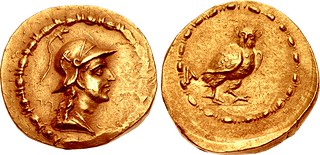
LOT 706–BAKTRIA, Indo-Greek Kingdom. Menander I Soter. Circa 155-130 BC. AV Stater (20mm, 8.57 g, 1h). Draped bust of Athena right, wearing crested helmet adorned with wing; all within bead-and- reel border / Owl standing right on ground line, head facing; A to left; all within bead-and- reel border. Bopearachchi 1A; MIG Type 211a (same obv. die as top example); SNG ANS 682; Boston MFA Supp. 312; Treasures of Ancient Bactria (Miho Museum), 46a (same dies); HGC 12, 494. EF, lightly toned, area of weak strike on obverse at periphery. Extremely rare, one of 13 specimens known. Estimated at $50,000.
Unlike his silver and bronze issues, the gold coinage of Menander I Soter is very rare (as is the case with Baktrian gold issues in general). This stater, with the helmeted head of Athena on the obverse and an owl on the reverse, is among the rarest, with a total of 13 specimens known. Mitchiner questioned the authenticity of some of the specimens he recorded, but did not doubt the British Museum specimen, which is struck from the same obverse die as the present coin. Bopearachchi, in a note on the series, repeated Mitchiner's reservation without further elucidation. S. Hurter, in her review of Le portrait d'Alexandre le Grand by O. Bopearachchi and P. Flandrin in SNR 85 (2006), expressed doubt about a number of the coins in the Miho Museum and suggested that the Miho Menander (which she had not seen) should undergo further examination (pp. 190–1).

LOT 924–Nerva. AD 96-98. AV Aureus (19mm, 7.59 g, 5h). Rome mint. Struck AD 98. IMP NERVA CAES AVG GERM P M TR P II, laureate head right / IMP II COS IIII P P, Aequitas standing facing, head left, holding scales in right hand and cradling cornucopia in left arm. Cf. RIC II 44 for type (denarius), otherwise unpublished. EF, lustrous. Unique. Estimated at $50,000.
A heretofore unknown and unpublished aureus for Nerva with the reverse legend of IMP II COS IIII P P. This Aequitas type is known for a denarius (RIC II 44), but only as an aureus with the AEQVITAS AVGVST reverse inscription. For this particular issue, there are six denarii types with only three corresponding aurei types (Fortuna, priestly implements, and clasped hands with legionary aquila on prow), so it stands to reason that the three previously unlisted aurei types (Aequitas–this coin, Libertas, and clasped hands) may eventually come to light.
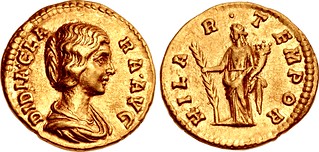
LOT 1024–Didia Clara. Augusta, AD 193. AV Aureus (20mm, 6.80 g, 12h). Rome mint. Struck under Didius Julianus. DIDIA CLA RA AVG, draped bust right / HILA R TEMPOR, Hilaritas standing left, holding in left hand a long palm frond set on ground and cradling cornucopia in right arm. RIC IV 10 (Julianus); Calicó 2402 (same obv. die as illustration); BMCRE 13 (Julianus) var. (obv. legend break); Biaggi 1053 (same obv. die); NAC 38, lot 94 (same dies); NAC 54, lot 483 (same dies). Near EF, a couple of very light scratches. Extremely rare. Estimated at $50,000.
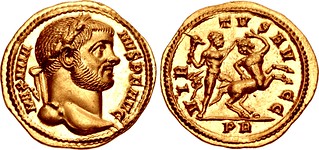
LOT 1089–Maximianus. First reign, AD 286-305. AV Aureus (19mm, 5.31 g, 6h). Rome mint. Struck AD 295-305. MAXIMIA NVS P F AVG, laureate head right / VIR TVS AV GG, Hercules standing right, leaning on hindquarters of centaur with his left knee and grasping the head of centaur with his left hand, holding upright club with his right hand, lion skin flowing behind his waist; the centaur is rearing up to the right, his head left, left hand raised in defense. RIC VI –; Depeyrot 5B/8 var. (bust draped and cuirassed); cf. Calicó 4740(obv.)/4739(rev.). Superb EF, perfectly centered. Very rare reverse type and an unpublished variety. Estimated at $50,000.
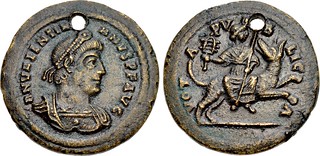
LOT 1105–Valentinian I. AD 364-375. Æ Medallion (24mm, 6.98 g, 12h). Festival of Isis commemorative. Rome mint. D N VALENTIN ANVS P F AVG, pearl- diademed and cuirassed bust right / VOT A PV B LIC A, Isis seated facing, her head right, holding sistrum with her right hand and a scepter with her left, on Sothis running right, who is looking back at her. Alföldi, Festival 90 (pl. XII, 16). Good VF, brown and tan surfaces with touches of green, holed in antiquity. Estimated at $3,000.
From the estate of Thomas Bentley Cederlind.
The Ptolemaic cult of Serapis and Isis enjoyed great popularity throughout Hellenistic and Roman times, and indeed the Romans, like the Greeks and Persians before them, were fascinated by the culture and monuments of ancient Egypt. The Ptolemies and the Roman emperors were not content with just being the foreign rulers of Egypt, but wanted to be viewed as legitimate successors of the Pharaohs. To this end, the Romans portrayed themselves as Pharaohs to the native population and even promoted the import of certain aspects of Egyptian culture and religion to their own native lands. The Egyptian concept of the Pharaoh as a god was appealing to the Roman emperors (the aging Julius Caesar was especially taken with this concept during his romance with Cleopatra).
The Isis festival was a major celebration in Rome in the 3rd and 4th centuries, heralding the arrival of the ship of Isis (navigium Isidis) from Alexandria on 5 March. Besides Isis and Horus, other members of the Egyptian pantheon appear–Serapis, Anubis, Harpocrates, and Nilus. Such coins or tokens with imperial busts were first struck by Diocletian at Rome to mark the arrival of the ship, and the tradition continued through the 4th century; the latest imperial bust to appear is that of Valentinian II. Alföldi proposes that in the Middle Ages the festival associated with the Isis ship (also known as carrus navalis) became the car naval or carnival.
Constellation of Varak/Mesha (Aries the Ram)

LOT 1310–INDIA, Mughal Empire. Nur al-Din Muhammad Jahangir. AH 1014- 1037 / AD 1605-1627. AV Mohur (22mm, 11.86 g, 10h). Zodiac Type, Class A. Fatehpur mint. Dually dated AH 1028 and RY 14 (19 December AD 1618 – 14/23 October AD 1619). Constellation of Varak/Mesha (Aries the Ram): ram, head right, recumbent left; radiate sun behind; sanat 14 jalus (regnal year 14) in Persian below / sikka-e zar gist ba-Fatahpur faruzada nur-i nam Jahangir Shah Akbar Shah (Gold coin became lustrous at Fatehpur by the light of the name of Jahangir Shah [son of] Akbar Shah) in Persian verse; AH date in lower left. Cf. Liddle Type G-74/G- 76 (for obv./rev.) = S. Bhandare, “Important Indian coins in the Kunsthistorisches; Museum, Vienna,” in ONS Journal 205 (Autumn 2010), Fig. 7/11 (for obv./rev. – same dies as illustrations); BM –; Wright –; Hull –; Nagpur –; Lucknow –; KM 180.2 (date unlisted) and cf. 150. 3 (rupee); cf. Friedberg 762 (for type with no distinction to mint). Good VF, field marks, two shroff marks on obverse, three on reverse, with ornate suspension loop attached. Extremely rare. Estimated at $20,000.

LOT 1571–temp. HANOVER. Charles Edward Stuart ‘Bonnie Prince Charlie'. 1720-1788. AV Medal (52mm, 74.55 g, 12h). Legitimacy of the Jacobite Succession. By T. Pingo. A later strike from dies made c. 1750. PRINCE CHARLES EDWARD STUART, bare head right / Charles in highland dress standing left, extending hand to Scotia standing right, holding spear and resting hand on shield; cornucopia on ground between; to left, Unicorn seated right on plinth; castle and ships in background; SEMPER ARMIS NUNC/ ET INDUSTRIA (Always with arms and now with diligence). Woolf 64.1 (unlisted in gold); Eimer, Pingo 6; MI 656/360 (unlisted in gold); Eimer 626. Choice EF, light die rust on reverse as usual. Considerable luster. Extremely rare in Gold. Includes old collection ticket. Estimated at $10,000.
Ex Property of a Gentleman (Sotheby's New York, 8 December 1992), lot 193, purchased from I. Snyderman (Art Trading Company), 16 January 1959; J. Pierpont Morgan Collection; reportedly also ex Thomas Fortune Ryan Collection.
Printed catalogs for CNG 102 are now available. To order the catalog, please call our U.S. office at (717) 390-9194. Catalogs have been mailed to customers on CNG's active mailing list. Prospective bidders may also view the virtual catalogs at CNG 102 Virtual Catalog. The sale can be viewed online at cngcoins.com, sixbid.com and numisbids.com.
In addition to Internet & Mail Bid Sale 102, CNG will also feature over 850 lots from many of the same collections listed above in their Electronic Auction 375, closing two weeks later on Wednesday, June 1, 2016, from 10AM ET (U.S.). Bidding for CNG Electronic Auction 375 will begin on May 11, 2016.
CNG is currently accepting consignments for future auctions sales. Please contact the firm for further details and consignment deadlines.
For further details and any additional information, please contact CNG, Inc. at:
Classical Numismatic Group, Inc.
Lancaster, PA 17608-0479
Telephone: (717) 390-9194
Email: cng@cngcoins.com

THE RISE OF PIRATE LIBRARIES
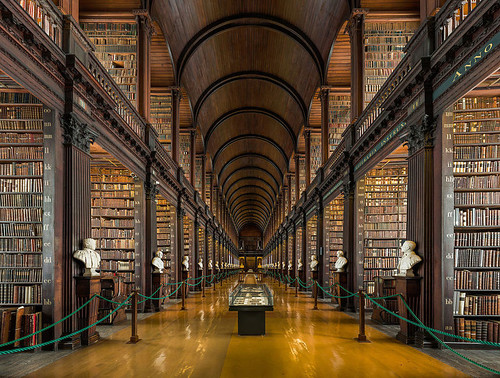
All around the world, shadow libraries keep growing, filled with banned materials. But no actual papers trade hands: everything is digital, and the internet-accessible content is not banned for shocking content so much as that modern crime, copyright infringement.
But for the people who run the world's pirate libraries, their goals are no less ambitious for their work's illicit nature.
“It's the creation of a universal library of the best stuff,” says Joe Karaganis, who studies media piracy at Columbia University's policy think tank, American Assembly. “That will not include the latest Danielle Steel novel.”
It does, however, include hundreds of thousands of books and millions of journal articles that otherwise are found only through expensive academic journals. Scanned or downloaded from journal sites, they are available through pirate libraries for free.
The creators of these repositories are a small group who try to keep a low profile, since distributing copyrighted material in this way is illegal. Many of them are academics. The largest pirate libraries have come from Russia's cultural orbit, but the documents they collect are used by people around the world, in countries both wealthy and poor. Pirate libraries have become so popular that in 2015, Elsevier, one of the largest academic publishers in America, went to court to try to shut down two of the most popular, Sci-Hub and Library Genesis.
These libraries, Elsevier alleged, cost the company millions of dollars in lost profits. But the people who run and support pirate libraries argue that they're filling a market gap, providing access to information to researchers around the world who wouldn't have the resources to obtain these materials any other way.
The lawsuits, wrote one group of pirate library supporters, “come as a big blow” to researchers whose only source of scholarly material is in these sites. “The social media, mailing lists and IRC channels have been filled with their distress messages, desperately seeking articles and publications,” the brief states.
In other words, they believe there are researchers who are never going to be able to pay the steep price of academic articles; either they use pirate libraries, which give them efficient access to information, or they don't get to read those books and journals at all.
To read the complete article, see:
The Rise of Pirate Libraries
(www.atlasobscura.com/articles/the-rise-of-illegal-pirate-libraries)
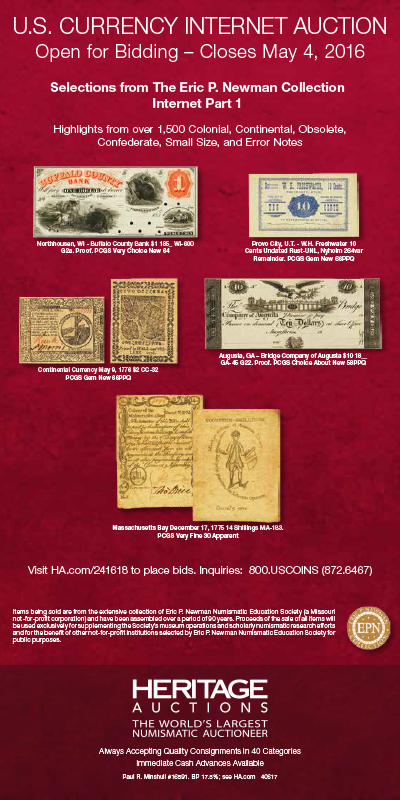
MORE BOOKS BOUND IN HUMAN SKIN
Leather-bound books are one of the finest ways to give your library a sense of gravitas and history. But books bound in human skin communicate more of a "serial killer" or "necromancer" vibe. Nonetheless, morbid tomes are fascinating artifacts from a time when gruesome human relics could still be created without winding someone up in jail. They are rare, but here are three places that still hold copies of books made out of a human's tanned epidermis.
SURGEONS' HALL MUSEUM
Edinburgh, Scotland

Scotland's Royal College of Surgeons at Edinburgh houses a great deal of interesting and somewhat morbid artifacts, but the most intriguing relate to the famous grave-robbing and murdering duo, Burke and Hare. In the late 1820s, the pair of dastardly entrepreneurs realized that they could make a pretty penny selling corpses to the surgeon's college for use as anatomical test templates. Unfortunately coming across naturally deceased corpses is a bit tricky and so the pair started making their own. They ended up murdering 16 people for the scheme by the time they were caught. Hare was released, but Burke was hung, dissected, and a book and card case were made of his skin, as though his life had not been morbid enough. Today the small notebook can still be found sitting under Burke's death mask in the college's museum, looking like a rather classy Moleskine.
BOSTON ATHENAEUM
Boston, Massachusetts
 When anthropodermic bibliopegy, or the practice of binding a book in human skin, was in vogue, it was often used as a chronicle of a
criminal and their deeds. Not unlike Burke above, convicted criminals would be executed, and their skin would be removed to create a book that
detailed their offenses. Just such a book is still held in a box in the Boston Athenaeum. Written by the bandit John Allen, and bound in his skin at
his own request, the full title of the book is, Narrative of the Life of James Allen, alias Jonas Pierce, alias James H. York, alias Burley Grove,
the Highwayman, Being His Death-bed Confession to the Warden of the Massachusetts State Prison. It is certainly a grim way to be remembered, but
honestly, you can't get much more personal that a memoir held in your own skin.
When anthropodermic bibliopegy, or the practice of binding a book in human skin, was in vogue, it was often used as a chronicle of a
criminal and their deeds. Not unlike Burke above, convicted criminals would be executed, and their skin would be removed to create a book that
detailed their offenses. Just such a book is still held in a box in the Boston Athenaeum. Written by the bandit John Allen, and bound in his skin at
his own request, the full title of the book is, Narrative of the Life of James Allen, alias Jonas Pierce, alias James H. York, alias Burley Grove,
the Highwayman, Being His Death-bed Confession to the Warden of the Massachusetts State Prison. It is certainly a grim way to be remembered, but
honestly, you can't get much more personal that a memoir held in your own skin.
JOHN HAY LIBRARY
Providence, Rhode Island
Other than criminals, the other main contributors to the genre of skin books were doctors. It was not uncommon for unique anatomical texts to be bound in the skin of a cadaver. The John Hay Library in Providence, Rhode Island has one such volume, as well as a pair of other skin books that are simply creepy. The book, De Humanis Corporis Fabrica (On the Fabric of the Human Body), is an early medical text written in the 1500s, but the copy in the John Hay Library was rebound in human skin in 1898. The other two skin books in the collection, which were also only rebound in the late-1800s are copies of The Dance of Death, collections of medieval woodcuts depicting the various ways people can die, via little tableaus of scythe wielding skeletons and the like.
To read the complete article, see:
Shelfies: 3 Places to Find Books
Bound in Human Skin (www.atlasobscura.com/articles/written-in-the-skin-3-places-to-find-books-bound-in-skin)
To read the earlier E-Sylum articles, see:
CREEPY HUMAN-SKIN BOUND BOOK OFFERED (www.coinbooks.org/esylum_v10n49a29.html)
HARVARD BOOK BOUND IN HUMAN SKIN (www.coinbooks.org/esylum_v17n24a26.html)
HARVARD BOOK NOT BOUND IN HUMAN SKIN AFTER ALL
(www.coinbooks.org/esylum_v17n16a29.html)

FEATURED WEB SITE: THE ROYAL NUMISMATIC SOCIETY
This week's Featured Web Site is The Royal Numismatic Society.The Royal Numismatic Society is the UK's foremost society for numismatics – the study of coins, medals and related currency items.
Founded in 1836 as The Numismatic Society of London, today's Society is international in subject and membership. Its lectures and publications deal with Classical, Asian, Medieval and Modern coins, paper money, tokens and medals, and Fellows include scholars and enthusiasts from around the world.
Meetings are held on the third Tuesday of the month between October and June, usually at The Warburg Institute, 6pm to 7.30pm, and are open to all.
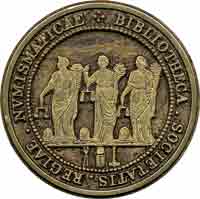
numismatics.org.uk

